Portugal’s capital city, Lisbon, is one of the most colourful, distinctive and enchanting cities in Europe and one of my personal favourites.
The city is such a delight to explore with it’s winding cobblestone streets, colourful tiled facades and stunning miradouros (viewpoints), but as it’s built across 7 hills you’ll want to plan your Lisbon itinerary carefully to get the most out of your time while saving your energy and legs!
I visit Lisbon (or Lisboa as the locals call it) often, as I have friends and family living in Portugal, and every time I come back I discover something new so I’ve put together the ultimate itinerary for Lisbon which will guide you through how to spend 3 days in Lisbon, Portugal – perfect for first timers.
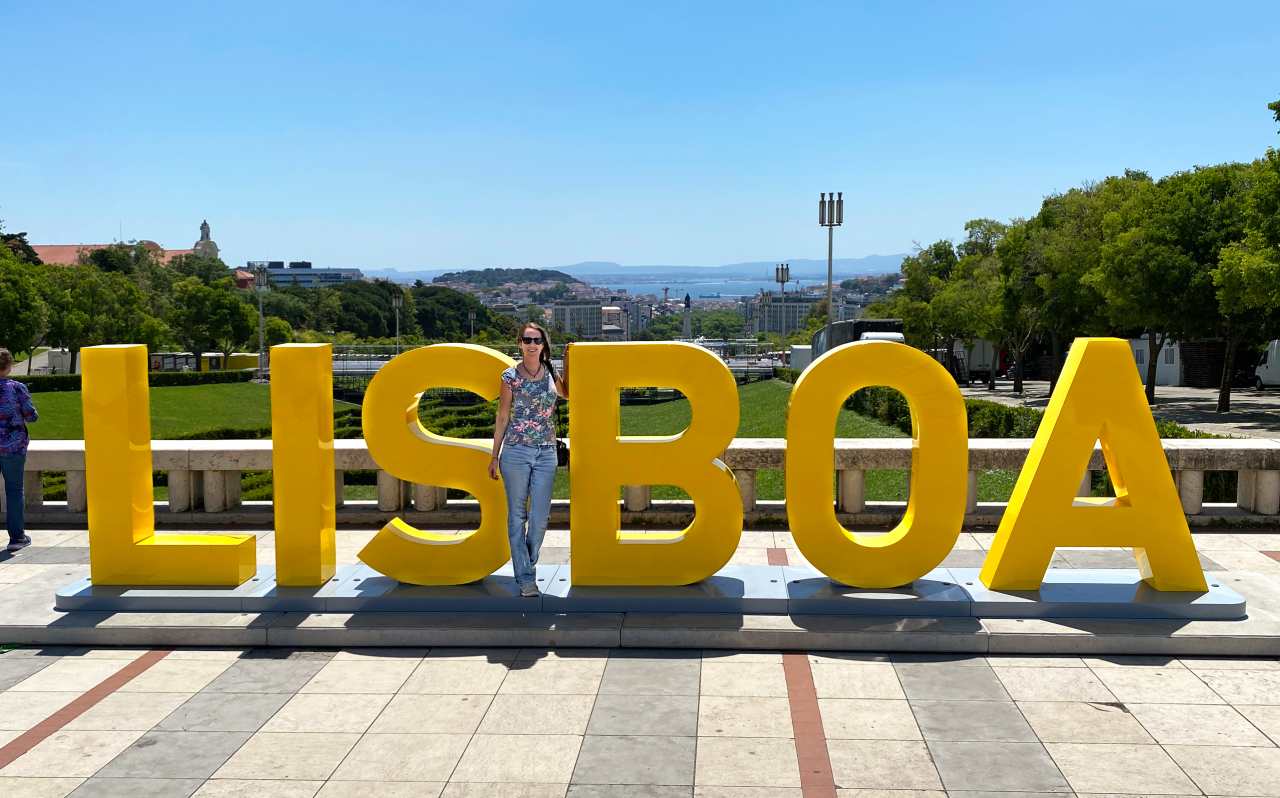
This Lisbon itinerary combines all the iconic tourist attractions in the charming Portuguese capital along with exploring the beautiful cobbled historic districts, riding the iconic old yellow trams, soaking the gorgeous views and exploring the fairytale castles of Sintra.
However many days in Lisbon you have to play with, you can tweak my itinerary to suit you. The first three days contain all the must-sees, and, if you have more time, I’ve also got some suggestions for exploring off the beaten track in less touristy neighborhoods, visiting interesting museums, hidden gems and nearby beaches and more beautiful places to visit near Lisbon – perfect for day trips.
I’ll also give you a mini Lisbon Travel Guide with all the tips you need including when to visit, where to stay, how to get there and get around. I hope you find my blog useful and that it inspires you to plan a trip to Lisbon and that this unique, enchanting city casts its spell on you too!
Pin Me 🙂
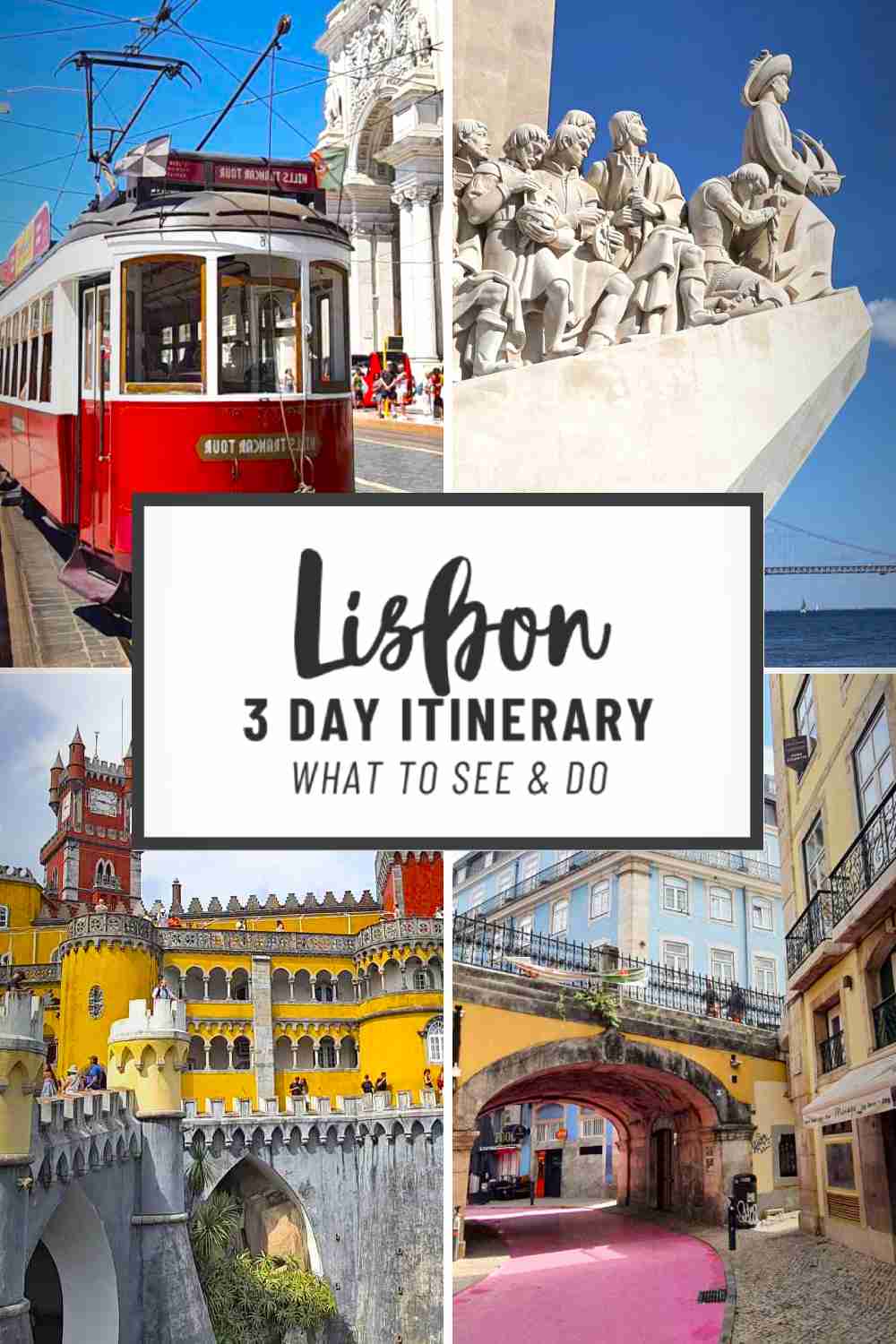
Quick Tips for Planning Your Lisbon Itinerary
- Best time to go:
Spring (April – June) or Autumn (September – October) for good weather and less crowds. Avoid the peak season (July and August summer holidays) crowds, hot weather and higher prices. - How long to spend:
At least 3 days. - How to get there:
Fly into Lisbon Airport (LIS) and take a short ride on the metro into the city centre. - Where to stay:
Baixa and Chiado are elegant, historic, centrally located and well connected areas with plenty of hotels, bars, restaurants, shops and attractions. Baixa is flatter and more walkable than other hilly areas. - Best hotels:
- $$$ Pousada de Lisboa – Gorgeous historic 5 star hotel on praca do commerico, the main plaza offering river views, elegant, spacious rooms and a pool in the most iconic location.
- $$ Hotel do Chiado – Lovely 4 star hotel with fantastic views over the city from the rooms and rooftop terrace, plus an amazing buffet breakfast
- $ Hotel Lis Baixa – Authentic, friendly Lisbon hotel on a quiet yet centrally located street. The rooms have little balconies and there’s an onsite restaurant offering al fresco dining.
- $ Lisbon Destination – Popular hostel located in Rossio train station with an amazing courtyard, free breakfast, and fun social activities. Both dorms and private rooms are available.
- Unmissable Experiences:
- Riding the iconic old yellow trams
- Exploring the historic Alfama district
- Admiring the views from a miradouro (viewpoint)
- Walking the walls of Castelo de São Jorge
- Exploring the palaces of Sintra
- Watching a Fado performance
- Savoring a fresh Pastel de Nata
- Cruising along the Tagus river at sunset
- Getting around:
Get a Lisbon Card or Navegante (VivaViagem) Card for unlimited metro, trams, buses, and some trains and ferries. Uber and Bolt apps are affordable and work well too. - Booking attractions:
Buy time slot tickets in advance for the major sights, like Pena Palace, to avoid disappointment. You can buy tickets, or join a guided tour that includes transport and tickets, on Get Your Guide.

How Long To Stay in Lisbon
The first thing to think about when planning your itinerary for Lisbon is how much time you have to spend as this will determine how much you can fit in to your trip.
You could easily spend a week in Lisbon and not get bored, but I know not everyone can get away for that long so in this itinerary I’ll show you how to fit the highlights into just 3 days in Lisbon.
While you could see some of the city’s highlights with just 1 or 2 days in Lisbon, I highly recommend spending at least 3 days in Lisbon so that you also have time to visit Sintra – these colourful fairytale castles are some of the most captivating sights in all of Portugal and make the ideal day trip from Lisbon.
If you can only spend 1 or 2 days in Lisbon then I recommend getting a private guided tour to make the most of our time. This private Lisbon Tour will take you the most famous sights in just one day, without the stress of navigating public transport or tiring your legs out from walking up and down hills, and the local guide will give you a good insight into the city.
If you have more time, spending 4 or 5 days in Lisbon is ideal as this will allow you explore at a more relaxed pace, check out some of city’s interesting museums and less touristy neighbourhoods, enjoy some time on the beaches near Lisbon and go on a day trip to see more of Portugal.
If you are visiting Lisbon as part of a trip around Portugal then I’d also highly recommend visiting Porto and the Douro Valley too. Portugal’s second city is less than 3 hours from Lisbon on the train and has a very different feel (and it’s just as beautiful).
In many ways, I enjoyed Porto as much as i do Lisbon! So I’d recommend spending at least 3 days in Lisbon and 2 in Porto for a more complete experience of Portugal. See my Portugal itinerary for more extended travel ideas.
Anyway, let’s get back to Lisbon!
How to Spend 3 Days in Lisbon – The Perfect 3 Day Lisbon Itinerary
Here’s how I recommend planning your 3 day itinerary for Lisbon:
- Day 1 – Lisbon’s Historic City Center, Alfama, Castelo de São Jorge, Fado show.
- Day 2 – Belem’s Monuments and Museums, LX Factory, Time Out Market, Sunset River Cruise.
- Day 3 – Day Trip to Sintra – Pena Palace, Moorish Castle, Quinta da Regalia.
Carry on reading for my day-by-day itinerary that goes into all the details, and offers suggestions for if you have more time.
Day 1 – Historic Lisbon, Castelo de São Jorge, Fado Show
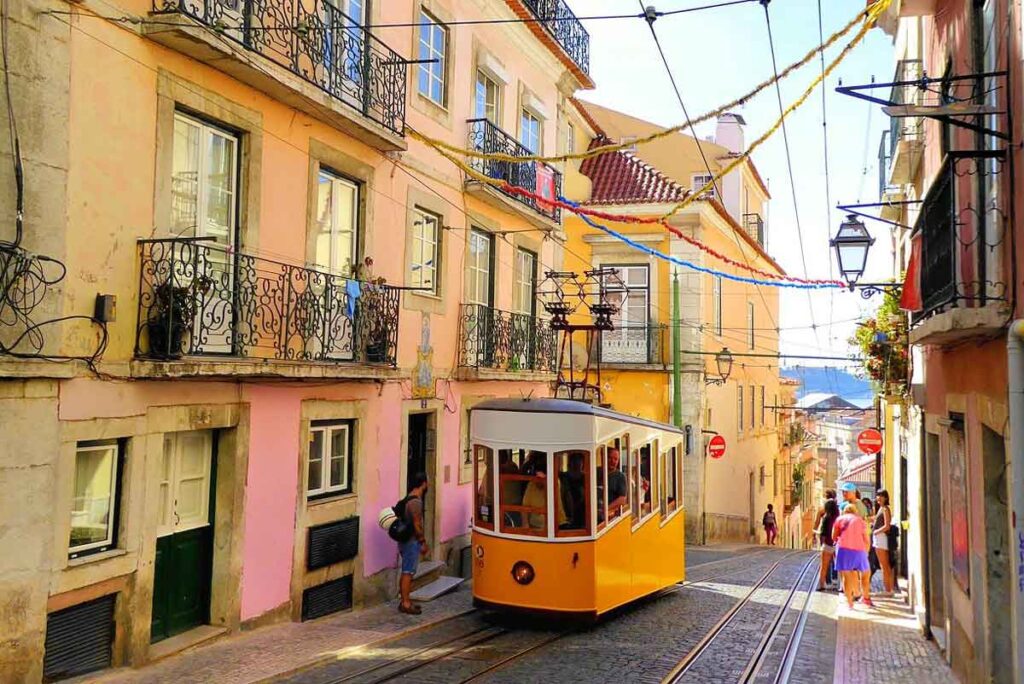
On your first day in Lisbon, dive straight into the city centre’s historic neighbourhoods – Baixa, Chiado, Bairro Alto and Alfama. These are Lisbon’s most atmospheric and enchanting areas where you’ll see plenty of impressive historical buildings, cobbled lanes, clattering trams, tiled facades, and sweeping river views.
Morning – Historic Lisbon Tour
Lisbon is a pretty safe city to explore independently, however the older districts of the city can be a bit of a maze, So, if it’s your first time in Lisbon, I highly recommend starting your trip by joining a walking tour (or a tuk tuk tour to avoid walking up and down hills.)
Not only will a guided tour help you get your bearings without getting lost, having a guide will also give you a deeper understanding of Portuguese history which will enrich your whole trip. Make sure you wear comfortable shoes with a good grip for walking up and down the steep hills.
Best Lisbon Tours
There are many tours available to help you learn about and navigate Lisbon – perfect for your first morning. Here’s my top recommendations:
- Lisbon Essential Walking Tour – This is the tour I took, its the perfect way to start getting to know the city and it’s rich history and culture in a small group with a local guide while exploring the most enchanting parts.
- Free Walking Tour – A great intro to the city’s history and layout. As it’s a free walking tour it’s usually a large group – make sure to bring cash as you’re expected to tip.
- Tuk Tuk Tour – A fun way to explore Lisbon’s hills and viewpoints without the uphill walking or tour groups. On a private tuk tuk tour you’ll be picked up from your hotel and whizzed around the city.
- E-Bike Tour – This Lisbon E-Bike Tour covers more ground than walking and includes all the historic city’s highlights and viewpoints. It’s ideal if you want to be more active while avoiding the exhaustion of cycling uphill.
- Food & Wine Tour – If you’re a foodie why not combine a walking tour with food and wine tasting – this tour includes 15 tastings of local dishes, wine, cheese, and pastel de nata, and insider tips of Lisbon’s food scene. It’s a great way to get your bearings and get familiar with Portuguese food early in your trip.
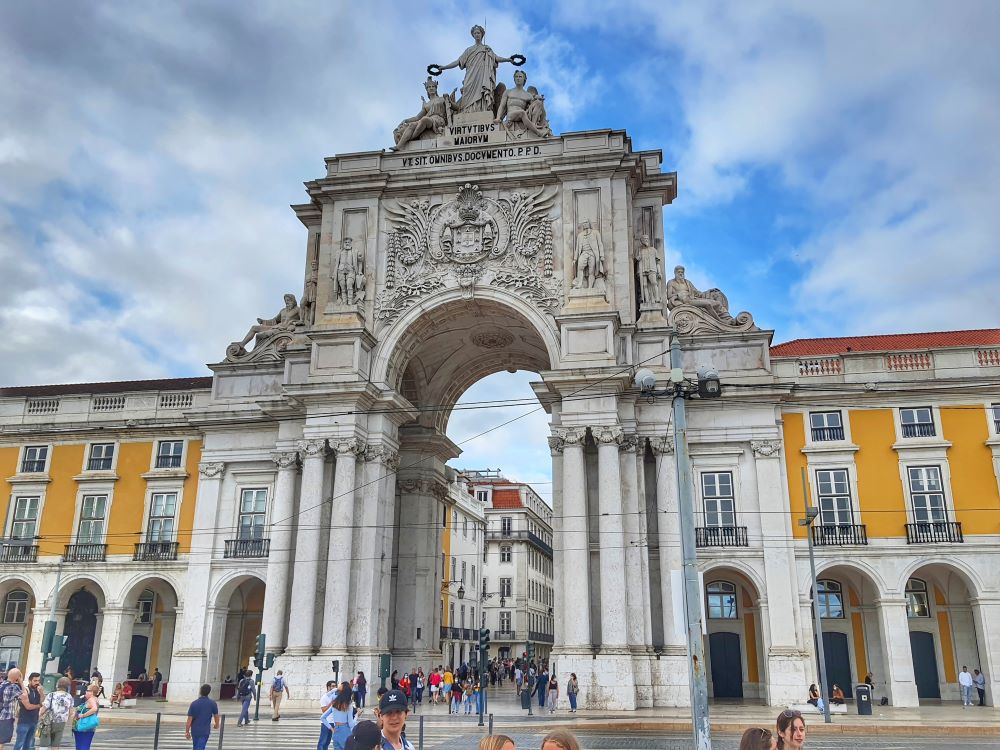
DIY Lisbon Walking Tour
If you’d prefer to explore independently, start your DIY walking tour at the Praça do Comércio, Lisbon’s grand riverside square where ships once arrived from all over the Portuguese Empire. You can visit the Lisbon Story Center, an interactive museum worth checking out to learn about the city’s history.
Climb up, or just admire, the Arco da Rua Augusta and wander along Rua Augusta, Baixa’s main pedestrian street. It’s full of shops, cafés, and buskers, but don’t eat here – it’s mainly aimed at tourists and pretty overpriced.
Wander towards the swirling pavements of Rossio Square keeping an eye out for one of Lisbon’s most quirky sights – the Elevador de Santa Justa (Santa Justa Lift.) This neo-Gothic iron elevator, built in 1902, connects Baixa to the higher Chiado district and was designed by a student of Gustave Eiffel.
The Elevador de Santa Justa is an impressive and unique sight but the queue is usually much longer than it takes to ride up the lift so I recommend just walking up if you can – it’s a steep but short walk and you can still see the views of Lisbon’s rooftops and the castle in the distance from the top anyway.
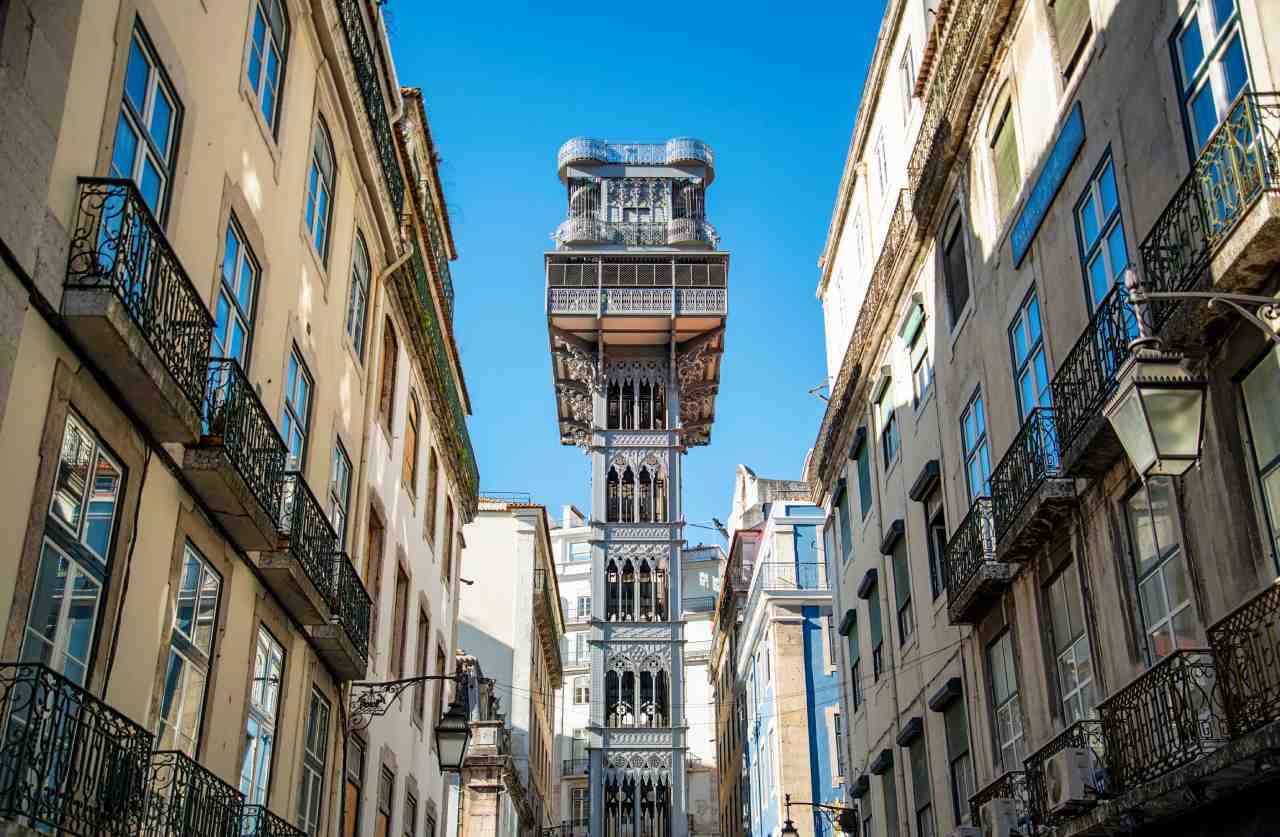
Once you reach the top check out the ruins of the Carmo Convent (Convento do Carmo.) This former Gothic church was almost completely destroyed in the earthquake, and the open-air skeleton of arches with no roof that remains is hauntingly beautiful. There’s a small museum here too.
Then head to Rua Garrett, one of elegant Chiado’s most beautiful streets, lined with shops and cafes. Check out the famous A Brasileira Cafe and the tile clad Livreria Bertrand – the oldest still operating bookstore in the world according to Guinness World Records.
Next head over to Praça Luís de Camões, a lively plaza that feels like the heart of Lisbon. Grab a pastel de nata from Manteigaria and take a pic of the super cute Bica Funicular and then try your luck catching the tram over to Alfama.
Ride Tram 28
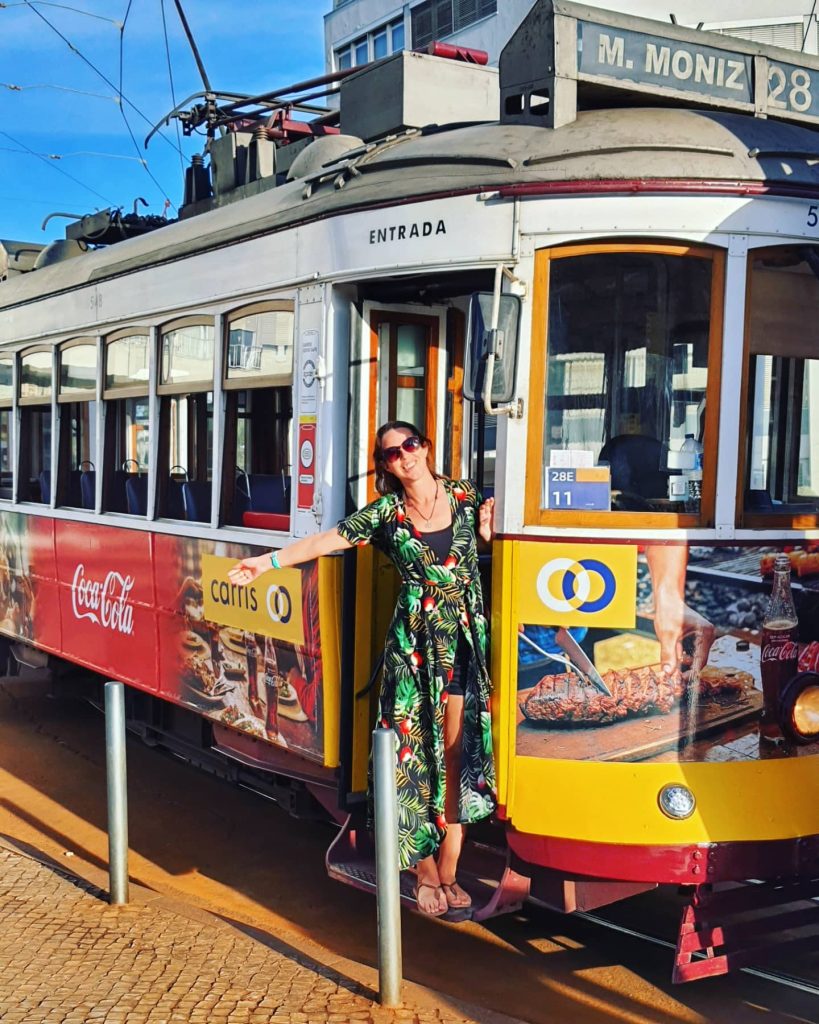
Lisbon’s old yellow trams are so iconic – they date back to the 1930s and, in any other city, would be in a museum, but in Lisbon they still trundle the streets and traverse the hills every day.
Riding the iconic yellow tram is a classic Lisbon experience and one of my favourite things to do in Lisbon. However, it does get crowded and it can sometimes be difficult to find a seat.
Tram 28 is the most scenic route – it twists, turns and rattles like a rollercoaster through the historic neighbourhoods and is such a fun and unique way to see the city, while saving your legs!
Try catching the tram at Praça Luís de Camões and riding it to Alfama. If the tram is too packed to get on, try boarding at the terminal at Martim Moniz instead where you’ll have a better chance of getting a seat. There’s more tips about using trams and public transportation in the Lisbon Travel Guide section at the end.
Afternoon – Explore Alfama and Castelo de São Jorge

Get off the tram at Sé de Lisboa (Lisbon Cathedral), the city’s oldest church, it has a slightly fortress-like vibe from the outside but is peaceful and atmospheric inside.
Have lunch at Taberna Do Castelo where you can taste delicious fresh Portuguese dishes like octopus, sardines and paella while sitting outside on the pavement soaking up the atmosphere as the trams rattle past.
After lunch, dive deeper into the historic Alfama district – the city’s oldest quarter and one of the few areas that survived the devasting earthquake of 1755.
Alfama is a labyrinth of and winding cobblestone streets, there’s no point trying to follow Google Maps here – just wander and you’ll discover hidden alleyways and staircases, locals chatting in doorways and laundry blowing in the breeze, tiny bars serving Ginjinha (cherry brandy) in little chocolate cups and the haunting sounds of Fado spill out over the red tiled rooftops.
If you’re interested in Fado, the melancholic music of Portugal, head down to the waterside and visit the Museu do Fado (Fado Museum) where you can learn more about this unique traditional artform.
And don’t miss the Miradouro de Santa Luzia and Miradouro das Portas do Sol – these two viewpoints offer those postcard-perfect vistas of the terracotta rooftops and the shimmering Tagus River below and are a great spot for photos.
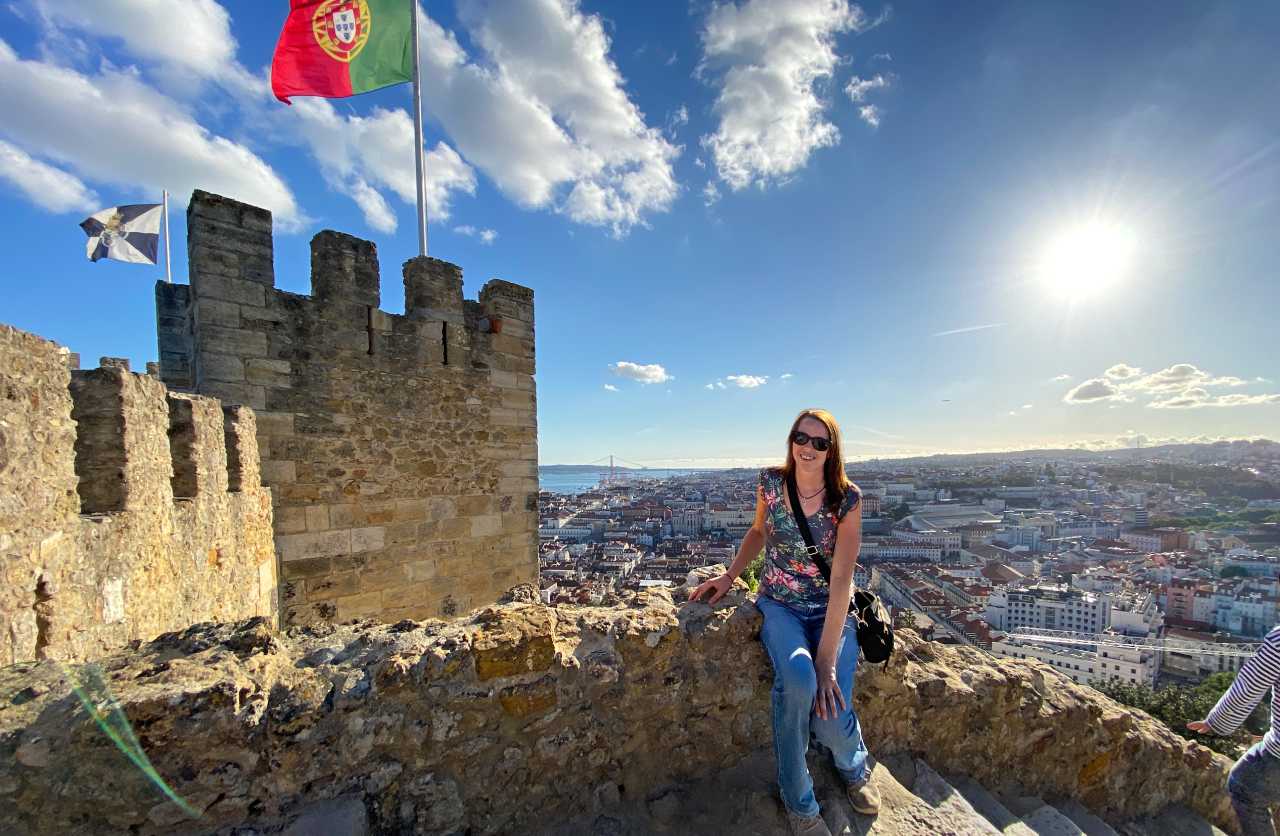
In the late afternoon, make your way up to Castelo de São Jorge (St George Castle), an impressive fortress perched at the top of the highest hill in Lisbon with a long and interesting history.
The walk up to São Jorge Castle is steep, but the reward is a 360-degree view of the city and a garden full of peacocks and shady olive trees. It’s one of Lisbon’s most visited sights for good reason – take the time to walk all around the castle walls and see the city below from every angle.
Entrance costs 15 Euros and the ticket office for Castelo de São Jorge is on Rua de Santa Cruz do Castelo. Try to time your visit for late afternoon when the crowds thin and the light gets golden. There’s a café and restaurant here where you can enjoy a drink with a view to toast the sunset.
Evening – Fado Show
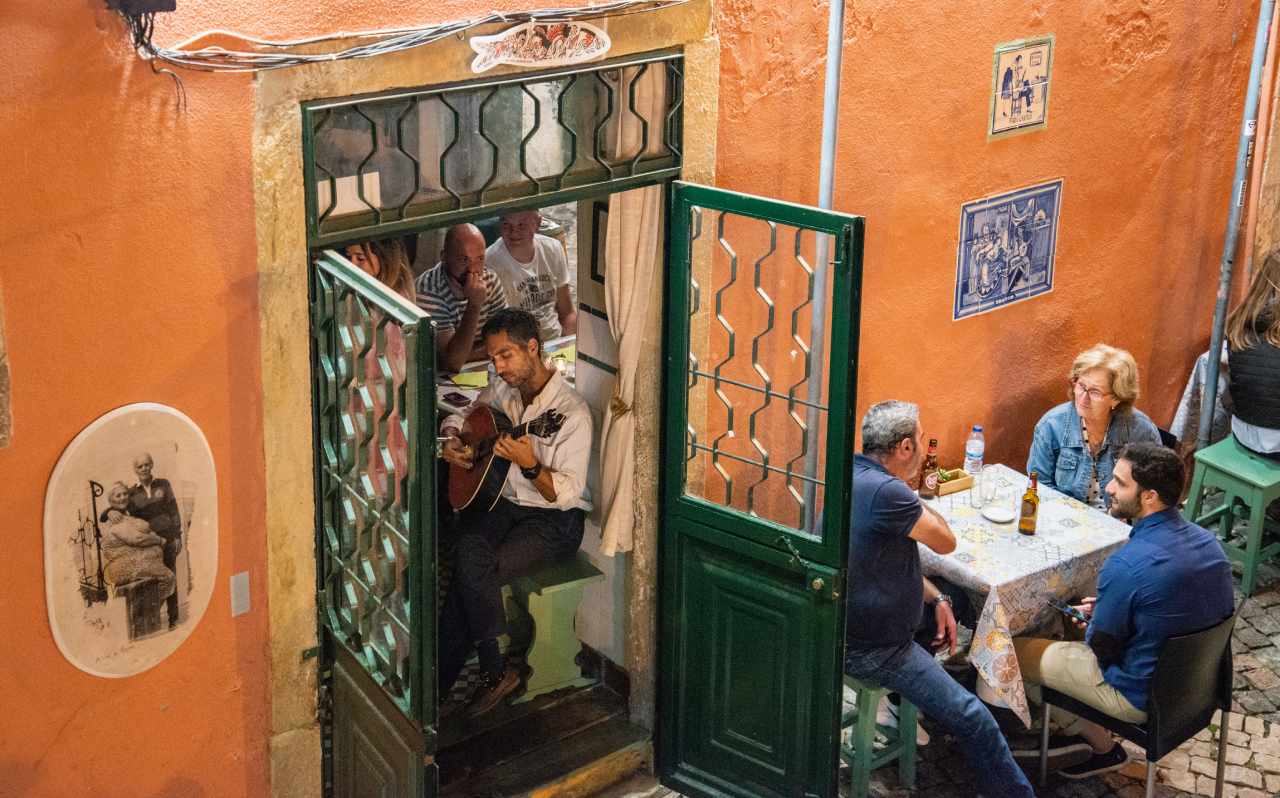
The perfect thing to do on your first night in Lisbon is to experience a traditional Fado show.
Fado is the traditional music that grew out of Lisbon’s old, working-class neighborhoods in the mid-19th century. It’s often described as Portugal’s version of the blues – soulful, melancholic songs that tell stories of lost sailors, unrequited love, and the bittersweet side of romance.
The word “fado” translates to “fate,” capturing the way destiny shapes the lives of Portugal’s seafarers and explorers and the families they leave behind longing for their safe return. This melancholic music is raw, emotional, and incredibly moving.
There’s plenty of places to experience Fado in Lisbon, from tiny hole in the wall joints in Alfama to polished performances complete with food, wine and an explanation/translation so you know what you are hearing!
This Fado Show and Portuguese Dinner is the perfect way to spend your first evening in Lisbon with authentic live performances in an typical Fado house in Bairro Alto, accompanied by traditional Portuguese food and wine. It’s popular and seats are limited so book in advance.
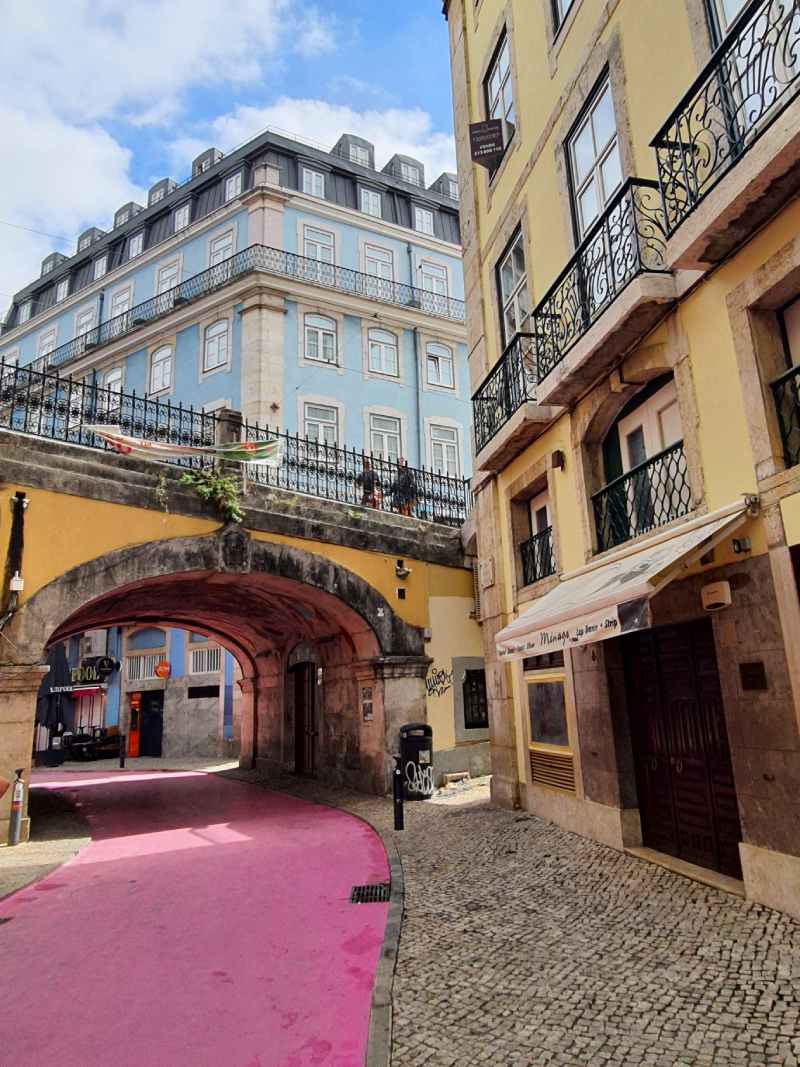
And, if you want to see more of Lisbon’s nightlife, you can carry on your night in the Bairro Alto area or head to nearby Pink Street. This lively street used to be Lisbon’s red light district but it is now full of bars and, yes, the street is actually painted pink! It also has a display colourful umbrellas installed above part of the street, making it an Instagram favourite.
Day 2 – Explore Belém’s Monuments and Museums
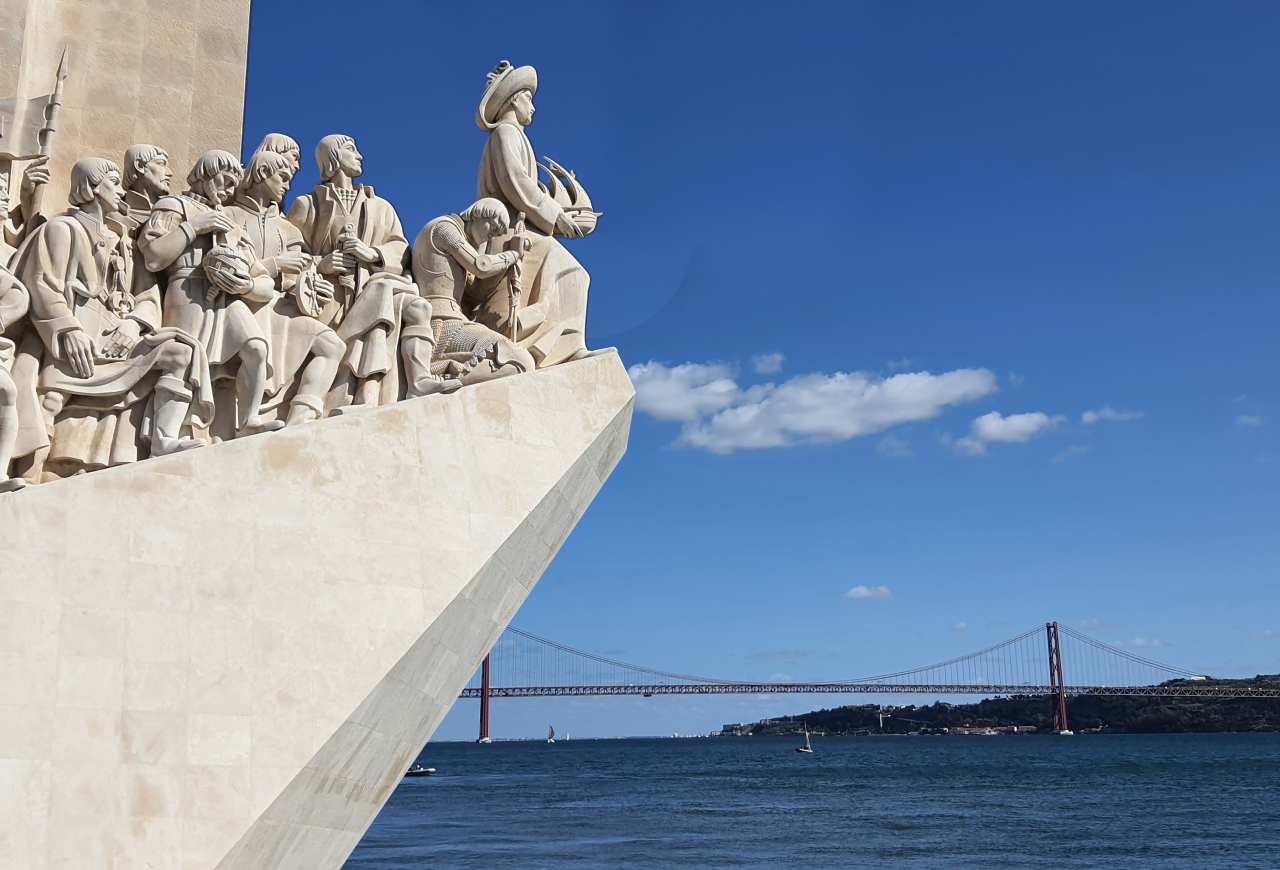
On your second day in Lisbon, head west along the river to the historic district of Belém – A relaxed, waterfront neighborhood where the Portuguese explorers set sail from during the Age of Discoveries.
Belem is an important place to visit if you want to learn more about Portugal’s famous explorers and seafaring history. Nowadays, it’s home to several of Lisbon’s most important monuments and museums, as well as some of the best pastries in the country.
Start your day early by hopping on a train, bus, tram 15E, or getting an Uber out to Belém – it only takes 10 minutes. You’ll want to dedicate most of the day here, as there’s a lot to see. This area is mostly flat and the sites are within walking distance, but if you want to understand more about what you are seeing then guided tours are available.
Morning – Jerónimos Monastery

Start your day at the Mosteiro dos Jerónimos (Jerónimos Monastery), a stunning UNESCO World Heritage site and a masterpiece of Manueline architecture. The intricately carved stonework, grand cloisters, and the tomb of Vasco da Gama give you a strong sense of Portugal’s golden age. There’s also a small archaeological museum here.
From there, take a short stroll over to Padrão dos Descobrimentos, (Monument to the Discoveries), which juts dramatically into the Tagus River. The 170 Ft (52 m) high monument is made up of a group of sculptures of famous Portuguese explorers in a shape that represents the prow of a caravel (sailing ship.) You can climb, or take an elevator, up to the top for a great view.
Also don’t miss the marble mosaic at the foot of the monument that represents a compass with a world map in the center – it shows you how far the Portuguese influence spread.
Not far from the Jerónimos Monastery is the original home of the Pastéis de Belém, arguably the most famous custard tarts in the world. The queue may look long, but it moves quickly, and it’s worth it. I like to grab a box to go and sit in the nearby park or by the riverside.

Next, walk along the waterfront to admire the iconic Torre de Belém (Belém Tower) a fortress-turned-symbol of Lisbon that once guarded the city’s harbor before being turned into a lighthouse and then a customs house.
Torre de Belém is one of the most impressive landmarks of Portugal and a great photo spot. Admire it from the outside or go inside to explore over the 5 floors from old dungeons to battlements and enjoy the view from the roof terrace.
Enjoy a delicious lunch by the waterside or marina. Try a restaurant like A Vela (Associação Regional de Vela do Centro) for freshly grilled fish and seafood in a relaxed outdoor setting overlooking the water.
Afternoon – Museums or LX Factory
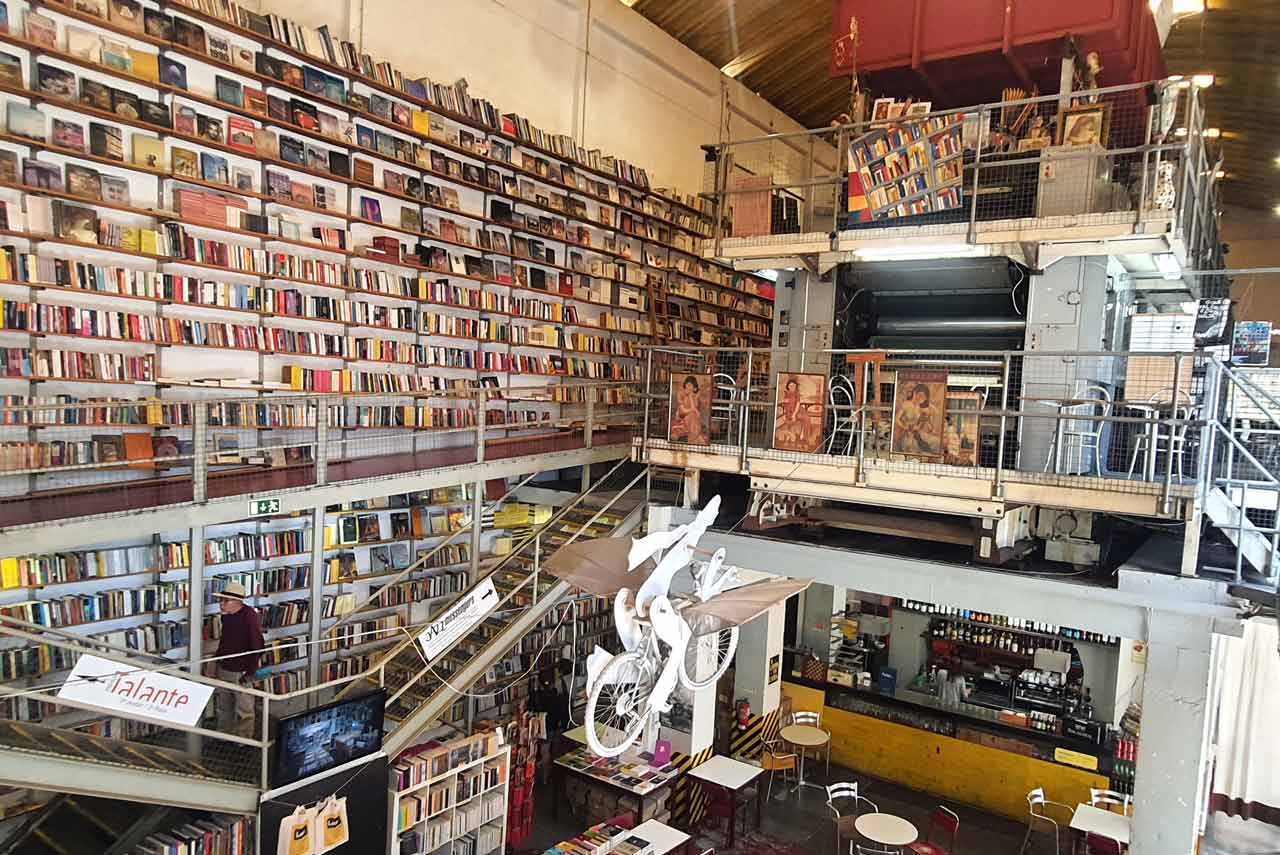
In the afternoon, either visit some of the nearby museums and art galleries in this area or, head back towards Lisbon city center checking out LX Factory on the way.
There’s so many museums and galleries in Belem you won’t be able to see them all in one afternoon so just pick the ones that interest you the most.
Some of the best museums and art galleries in this area are:
- Museu de Marinha (Maritime Museum) – tells the story of Portugal’s seafaring history with detailed ship models, ancient maps, royal barges, and even a seaplane. It’s a must if you’re into naval history or just want a better understanding of how Portugal became a global empire.
- Museu de Arte Contemporânea (Museum of Contemporary Art) – a major modern art museum featuring an impressive range of contemporary works by both Portuguese and international artists like Warhol and Picasso and other 20th-century masters.
- Lisbon Earthquake Experience (Quake Museum) – a highly immersive museum that explores the dramatic impact of the 1755 Lisbon earthquake through interactive exhibits and simulations. It’s a great way to understand how this disaster reshaped the city’s history and architecture.
- Museu Nacional dos Coches (National Coach Museum) – one of the most unique museums in Lisbon, showcasing ornate royal carriages from the 17th to 19th centuries in the old royal riding school.
- MAAT (Museum of Art, Architecture and Technology) – known for its striking “spaceship-like” riverside architecture and thought-provoking contemporary exhibitions.
- Museu de Arte Popular (Folk Art Museum) – a smaller museum highlighting Portuguese folk art and traditional crafts, housed in a charming 1940s building on the riverside.
If you’re not so interested in historical museums you could check out LX Factory, a vibrant creative hub housed in a former industrial complex between Belém and downtown Lisbon.
LX Factory is packed with quirky independent shops, trendy cafes and restaurants, bookstores, art spaces and creative studios. It’s worth checking out on your way back to Lisbon, especially if it’s a Sunday when the flea market is on.

Evening – Tagus River Cruise and Time Out Market
The best way to wrap up your day in Belem is to take to the water yourself with a relaxing sunset river cruise along the Tagus. You’ll see Lisbon sights from a different perspective, shimmering in the golden light as the sun dips behind the 25 de Abril Bridge.
There are several options leaving from Belém or nearby docks – some are more like party cruises with a free bar and DJ onboard, while other’s offer a more relaxing experience with live music and a glass of wine to toast the sunset.
This Sunset River Cruise leaves from Doca de Belem includes a relaxing, scenic 2 hour sunset cruise on a sailing boat with complimentary glasses of vinho verde – a lightly sparkling traditional Portuguese wine.
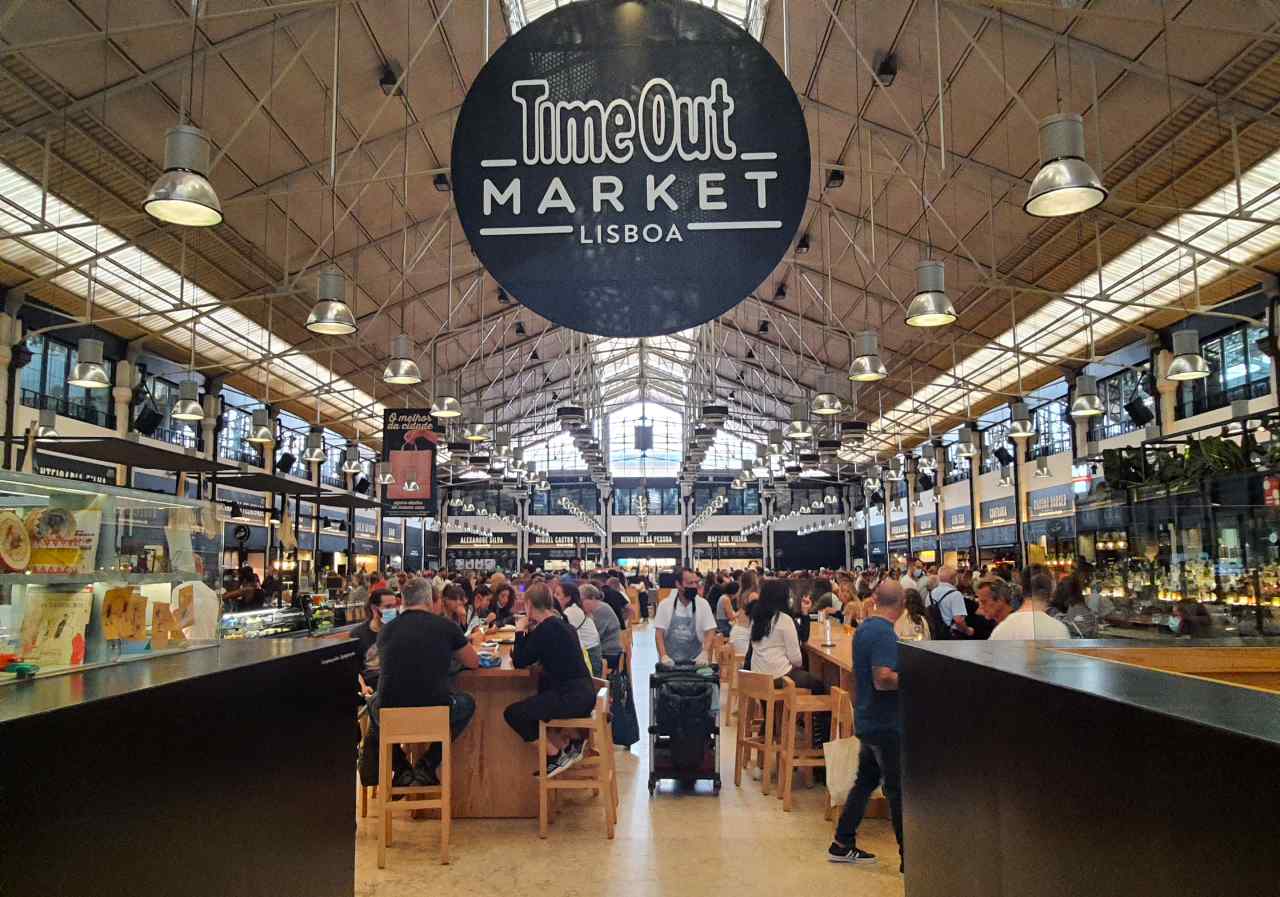
After the cruise, travel back to the city center by train or tram and get off at the last stop at Cais Do Sodre, and you’ll be across the road from the excellent Time Out Market – the best spot for dinner.
Located in the huge Mercado da Ribeira, the famous Time Out Market Lisboa showcases the best of traditional Portuguese cuisine with a selection of Lisbon’s best restaurants and bars. It’s basically where you’ll find the best food in the city all under one roof and it’s open until midnight!
Come hungry and try as many classic Portuguese dishes as you can! Top dishes to try include
- Bacalhau à Brás – Shredded salted cod stir-fried with onions, thin potato strips, and scrambled eggs.
- Sardinhas Assadas – Chargrilled fresh sardines served with bread or salad, especially in summer.
- Caldo Verde – Comforting potato and kale soup with slices of smoky chouriço sausage.
- Francesinha – Porto’s indulgent sandwich stacked with meats, melted cheese, and a rich beer-tomato sauce.
- Pastéis de Nata – Flaky pastry custard tarts with a caramelized top, best sprinkled with cinnamon.
Day 3 – Day Trip to Sintra
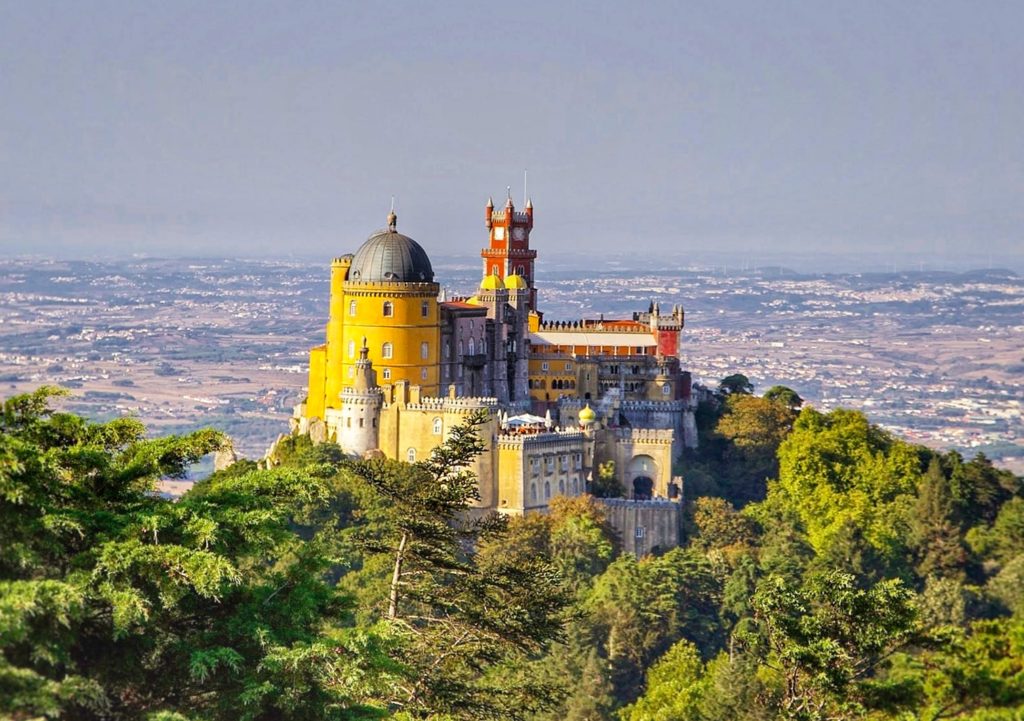 One of the best places to visit in Portugal is Sintra, a UNESCO world heritage site with colourful fairy-tale palaces, misty forested hills, and mysterious gardens.
One of the best places to visit in Portugal is Sintra, a UNESCO world heritage site with colourful fairy-tale palaces, misty forested hills, and mysterious gardens.
It’s possible to visit Sintra on a day trip from Lisbon, it seems to be on everyone’s Portugal itinerary so it does get busy and you need to book time slot tickets in advance.
There’s two ways to do it – either by taking public transport and booking your tickets yourself to avoid wasting time queuing, or by joining an organised tour of the highlights which includes transport, tickets and lunch – this allows you to see more with less stress.
To do it DIY, take the train from Rossio Station in Lisbon to Sintra – it’s a direct 40-minute ride and runs frequently throughout the day (No need to pre-book the train; just use your Viva Viagem card)
Once you arrive at Sintra station take the 434 tourist hop on hop off bus from outside the station which will take you up the hills to the palaces. (To prevent congestion private cars are not allowed around Sintra and it’s a bit of a long, steep walk between places.)
Morning – Pena Palace and Moorish Castle
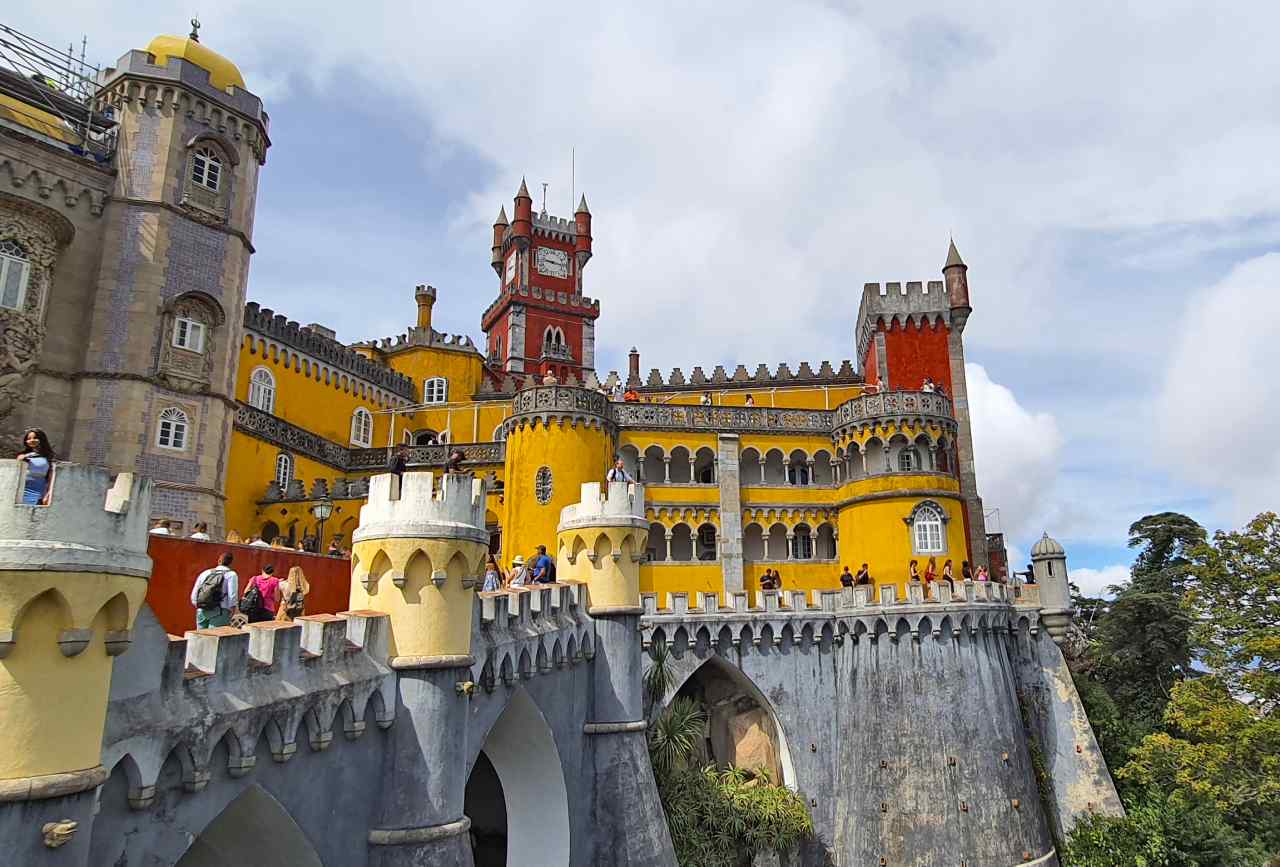
Start your day by heading straight to Palácio da Pena (Pena Palace.) This whimsical 19th-century palace perched above the clouds is the most iconic sight in Sintra, with brightly colored towers, Gothic gargoyles, immaculate interiors, and sweeping views all the way to the sea from the terraces.
Pena Palace is magical but extremely popular so now it operates on a timed entry system and you need to book your tickets in advance as it often sells out. You can book Pena Palace tickets here – try to get the earliest time slot available to avoid the crowds.
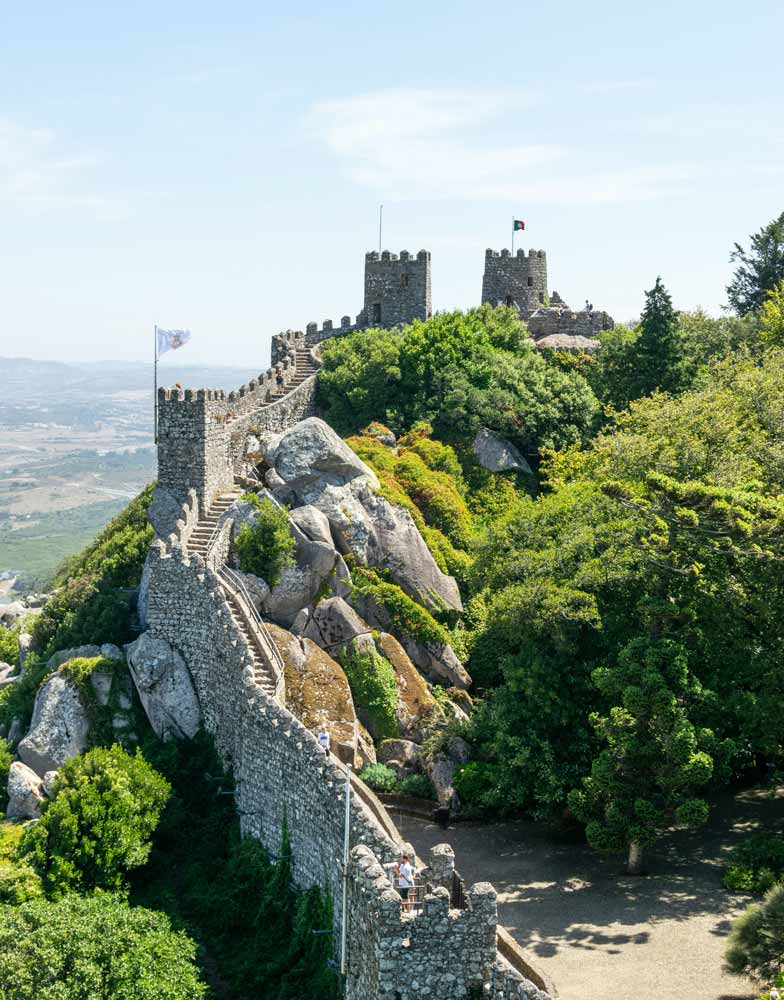
After exploring Pena Palace, you can walk through the forest to the Castelo dos Mouros (Moorish Castle) a rugged 8th-century fortress with crumbling stone ramparts and panoramic vistas. The Moorish Castle isn’t an opulent palace but it’s worth visiting for the views alone, plus it’s usually not as busy as the other sights in Sintra and you get a great view of the Pena Palace peeking out from the trees.
Next, head down into the centre of Sintra town where you’ll find winding streets of beautiful historic buildings and lovely traditional tavernas perfect for lunch. Try Tascantiga, a terrace restaurant tucked away near the National Palace serving excellent petiscos (Portuguese tapas), or grab some fast food from a pastelaria in the town center.
Afternoon – Quinta da Regaleira
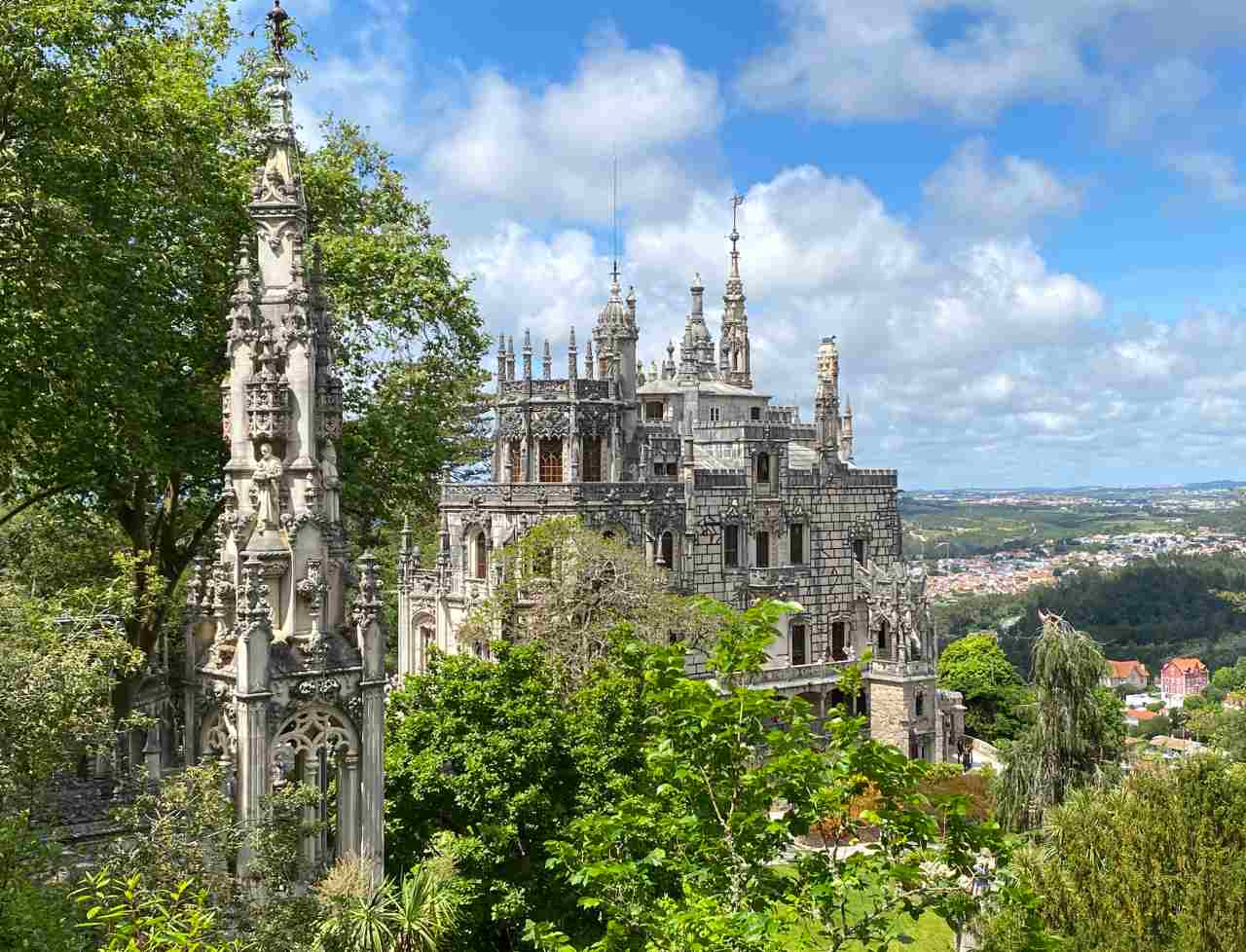
After lunch, explore the Palácio Nacional de Sintra (National Palace of Sintra) also known as the Town Palace. This is Portugal’s best-preserved medieval royal residence, the rooms are beautiful and contain impressive azjuelos (tiles) and coats of arms on the ceilings.
Then make your way to the Quinta da Regaleira, an ornate, slightly eerie estate known for its Initiation Well, underground tunnels, esoteric architecture, and lush, symbolic gardens. It’s the kind of place where you’ll want to get lost for a while. The Quinta da Regaleira was my highlight of Sintra – don’t skip it!
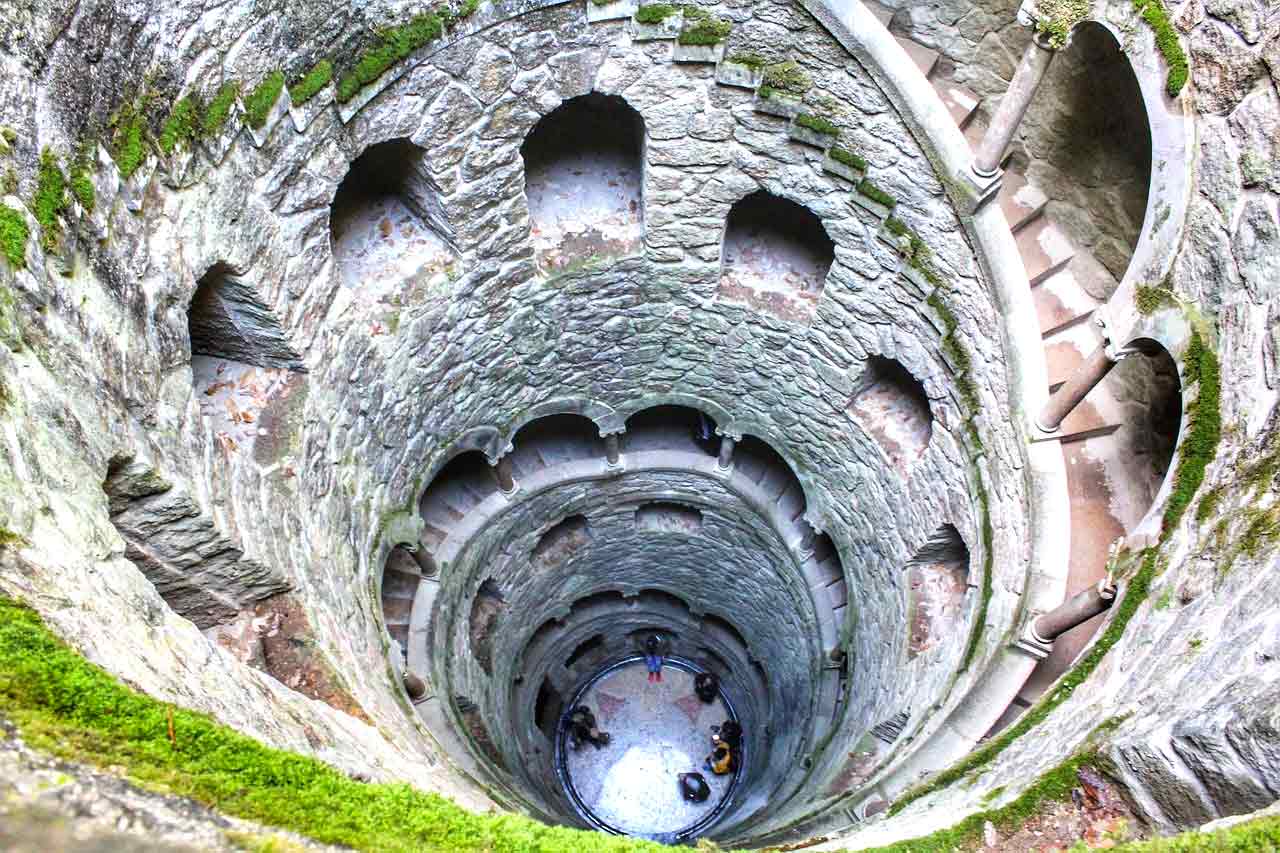
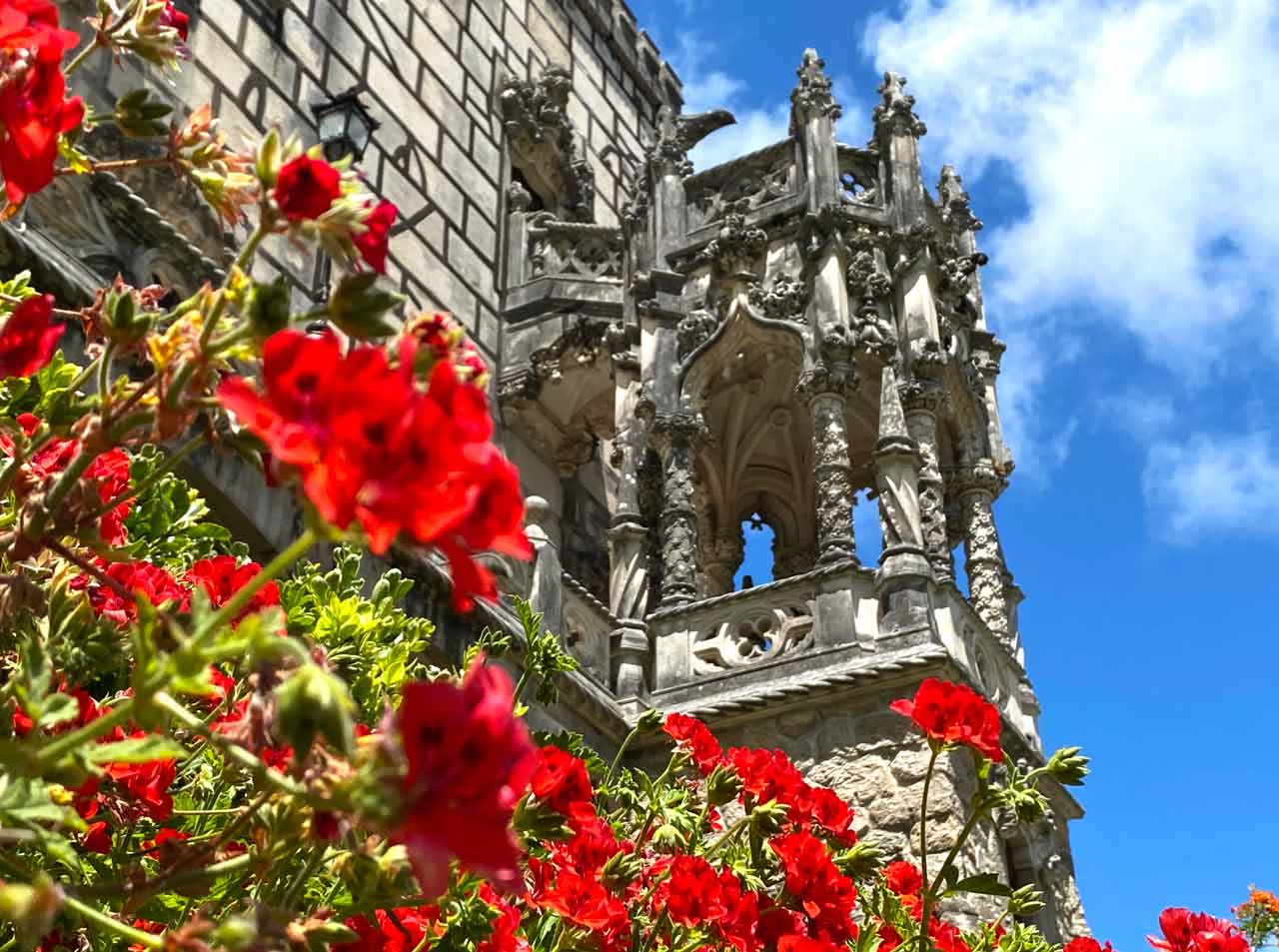
There’s a lot to see in Sintra, and it takes a while to get around those winding hills. While you can do it public transport, but it can be a bit tricky to ensure you arrive in time for your time slot – it’s much easier to just join a guided small group tour.
Some tours also include stops at Cabo da Roca, a dramatic cliff at the westernmost point of mainland Europe, and the charming seaside towns of Cascais and Estoril, which would be complicated to get to on public transport.

This top rated Sintra and Cascais Full-Day Tour combines Sintra, Pena Palace, the Moorish Castle, Quinta da Regaleira, Cabo da Roca and Cascais in a single day with transportation and fast track tickets taken care of so you can just focus on enjoying the experience. The local guides also really help to bring the incredible history and architecture to life.
Evening – Lumi Rooftop
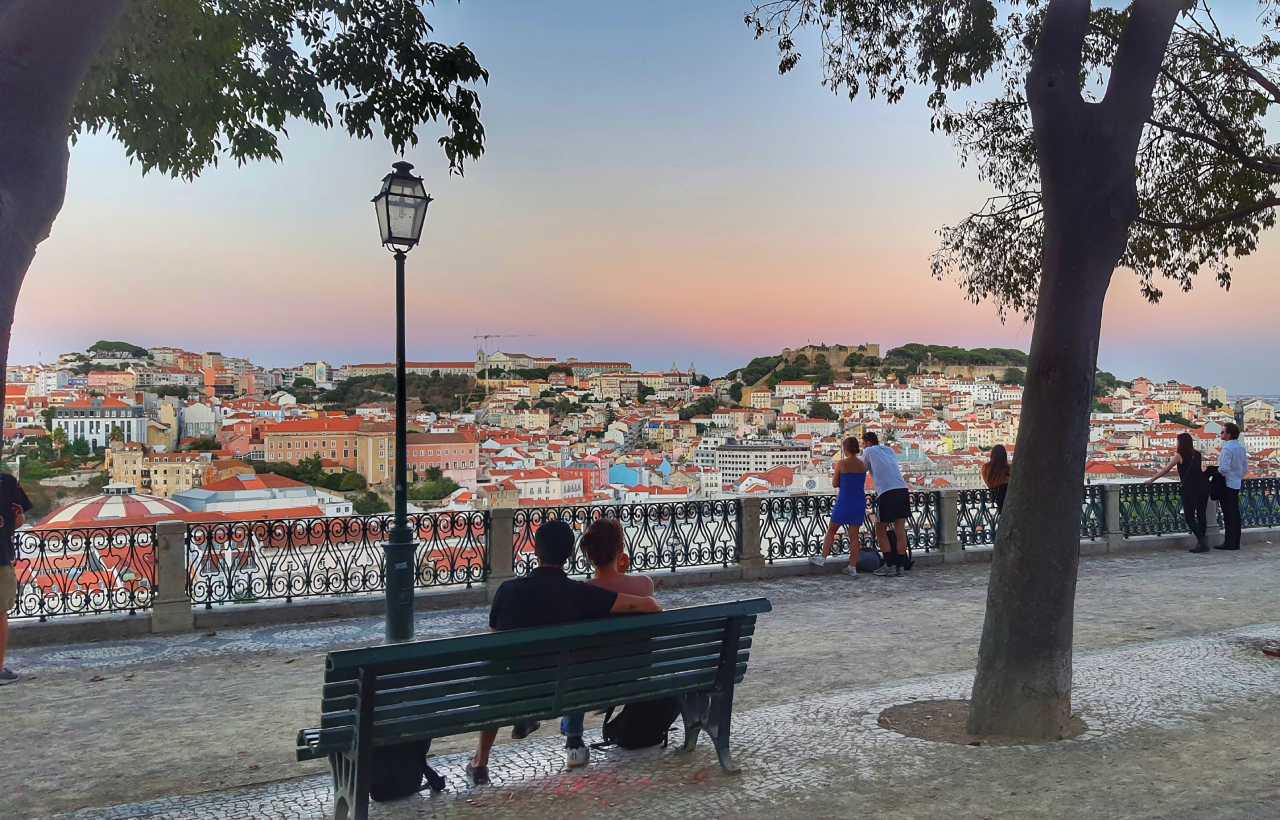
When you get back to Lisbon, if you still have the energy for another viewpoint head to Miradouro de São Pedro de Alcântara in Bairro Alto – one of my favourite viewpoints in the whole city. It’s really close to Rossio station, so if you traveled to Sintra by train it’s really convenient. If your legs are tired you can even get the Ascensor Glória up.
For dinner, there’s lots of restaurants nearby in Bairro Alto but if you’re after a special way to spend your last night in Lisbon I suggest the Lumi Rooftop at Lumiares Hotel. This is an award‑winning rooftop restaurant and cocktail bar in the heart of Bairro Alto, consistently voted one of Europe’s best rooftops, has stunning views and a menu of exceptional fresh Portuguese cuisine – think roasted octopus, tuna ceviche, peixinhos da horta, and inventive cocktails. It’s the perfect way to round off 3 days in Lisbon!
More Things to do in Lisbon – Options for Days 4 and 5
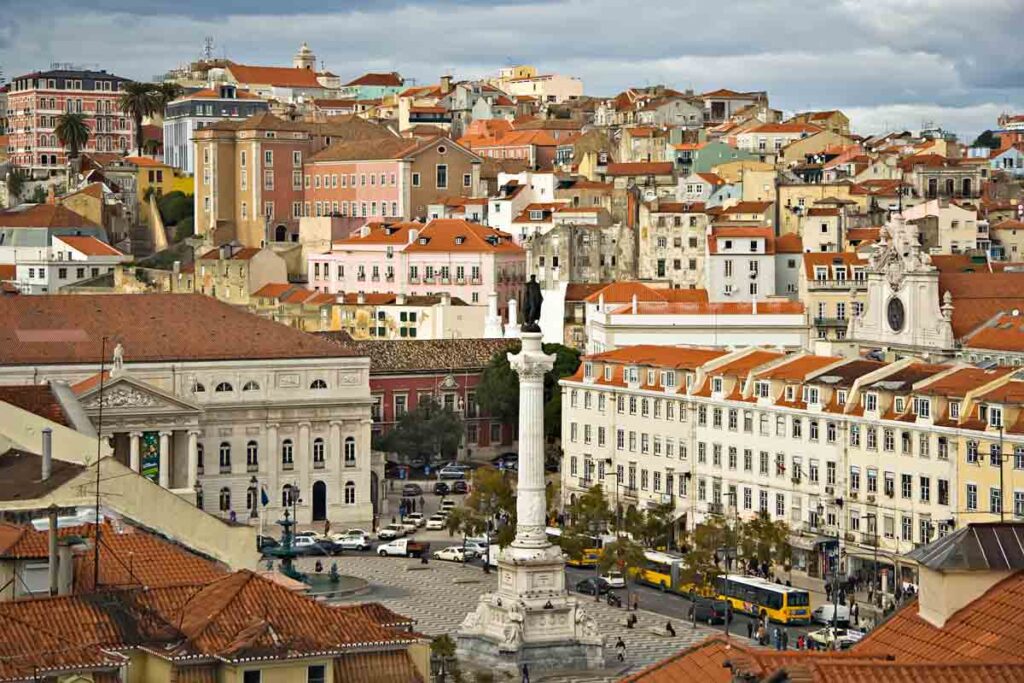
The first three days of this Lisbon itinerary have included all the must sees for a first time visitor, but it’s well worth spending a few more days in Lisbon if you can.
If you have more time, spend 4 or 5 days in Lisbon, this will allow you to take things at a slower pace, visit some more museums, or just get off the beaten track and discover some hidden gems. If you’d like to see more of Portugal, you could also take some more day trips from Lisbon.
Here’s some ideas of more things to do in Lisbon and nearby:
- Visit the National Tile Museum (Museu Nacional do Azulejo). It’s a bit out of the way but worth the effort. Set in an old convent, the museum tells the story of Portugal through its famous blue-and-white tiles, and the building itself is beautiful.
- Ride the whole route of Tram 28. Get on at Martim Moniz so you get a seat and ride the tram through the steep, historic, winding streets that even buses can’t reach. The end point is Campo de Ourique but I think it’s worth getting off just before at Estrela Basilica, an impressive white-domed church, and spending some time in Jardim da Estrela, the peaceful gardens opposite. It’s feels like a hidden gem – not many tourists make it here.
- Join a Pastel de Nata Cooking Class and learn how to make the iconic Portuguese dessert yourself! In a small group, you will be guided through the whole process to bake (and eat) your own pastel de nata. Or, for the full experience, try a Portuguese cooking class where you’ll also learn how to make classic Portuguese dishes while enjoying nibbles and drinks.
- Explore the viewpoints of Graça. (Take the tram to Graça to avoid climbing all the way!) This area has a couple of Lisbon’s best viewpoints – Miradouro da Graça, next to the church, is where you’ll get that iconic view of the castle. There’s a cute coffee and wine bar here too. If you have more energy, carry on walking up to Miradouro da Senhora do Monte – another churchyard with the highest point in the neighborhood that offers the most panoramic views of the city.
- Check out the more modern parts of Lisbon at the Parque das Nações a modern marina and waterfront area where you can visit the Lisbon Oceanarium, shop at the Vasco da Gama Centre and even ride a cable car above the waterfront.
- Visit the Parque Eduardo VII, the largest park in Lisbon that offers great views over the greenery down to the city and the river beyond and the big yellow Lisboa sign.
Day Trips from Lisbon
Lisbon makes a great base for exploring central Portugal and there’s plenty of easy day trips you can do from the capital. Sintra is the most popular day trip and a must do, but there are plenty of other options if you have more time. Here’s a few ideas:
Cascais
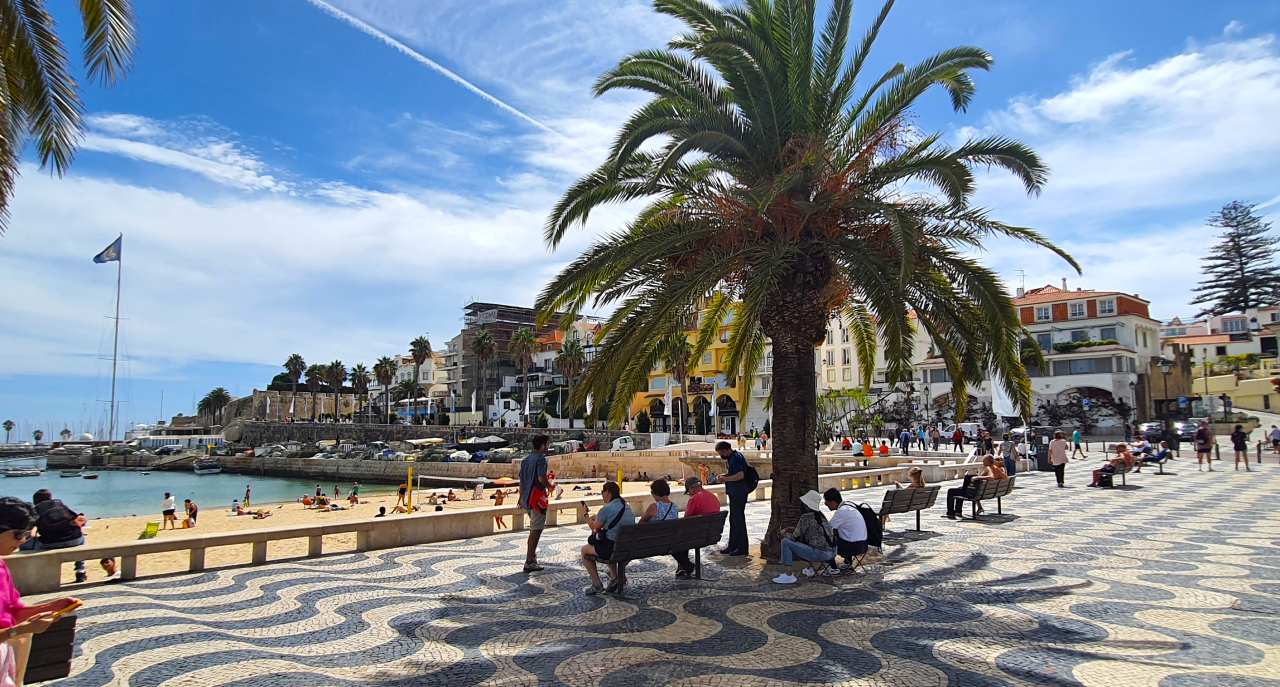
Cascais is a charming seaside town, and former royal retreat, with a colorful old town, lovely marina, excellent seafood restaurants and nice town beaches. The museums and art galleries are worth visiting and you can also check out Boca do Inferno, a dramatic sea arch, join a surf lesson at Guincho Beach, or take a stroll along the coastal promenade to Estoril. The casino at Estoril is said to have inspired Casino Royale!
Getting there: Cascais is just 40 minutes by train from Lisbon, trains go from Cais do Sodré station and offer a scenic coastal ride.
Óbidos
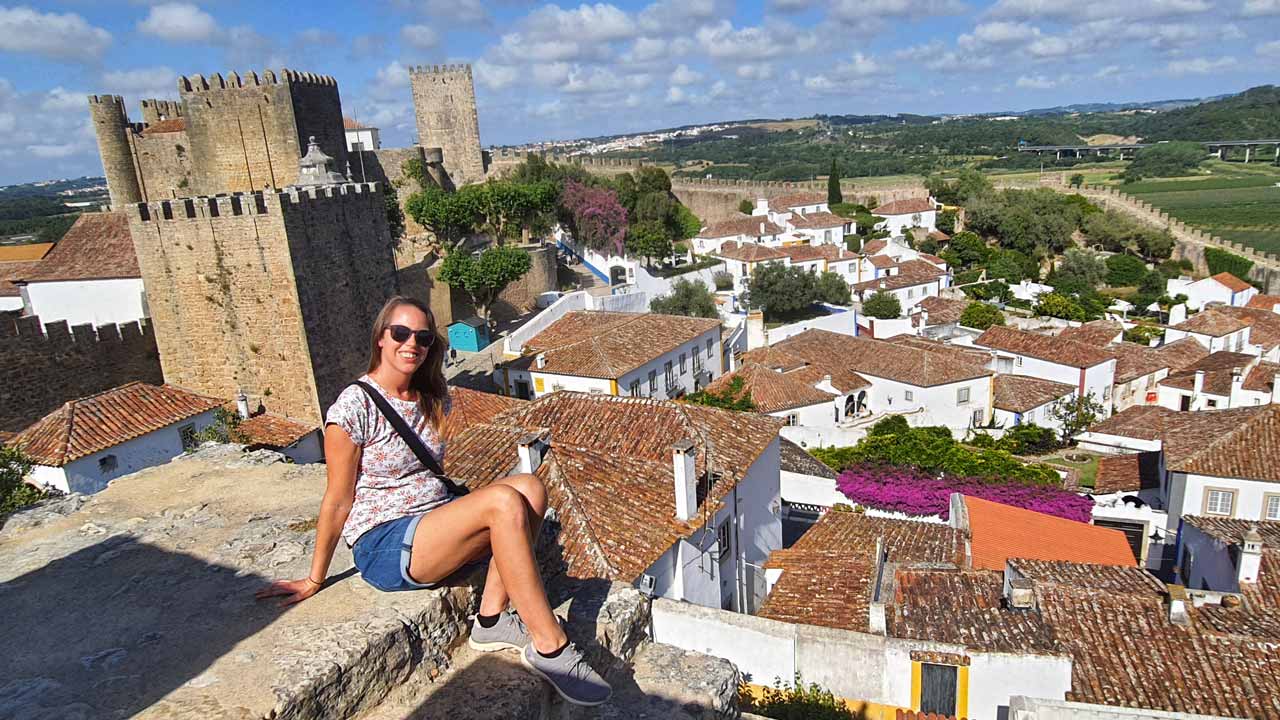
Óbidos is a beautifully preserved medieval town surrounded by stone walls, perfect for wandering the cobbled streets, climbing the castle walls, sipping local ginjinha in a chocolate cup and soaking up one of the prettiest towns in Portugal.
Getting there: Obidos is about an hour north of Lisbon and can be reached by bus.
You could combine the trip to Óbidos with a visit Peniche and Nazaré nearby – two famous surf towns where you’ll find some of the biggest waves in the world. If you’d like to fit them all in one go, consider this day tour to Óbidos, Nazaré, and Peniche.
Ericeira
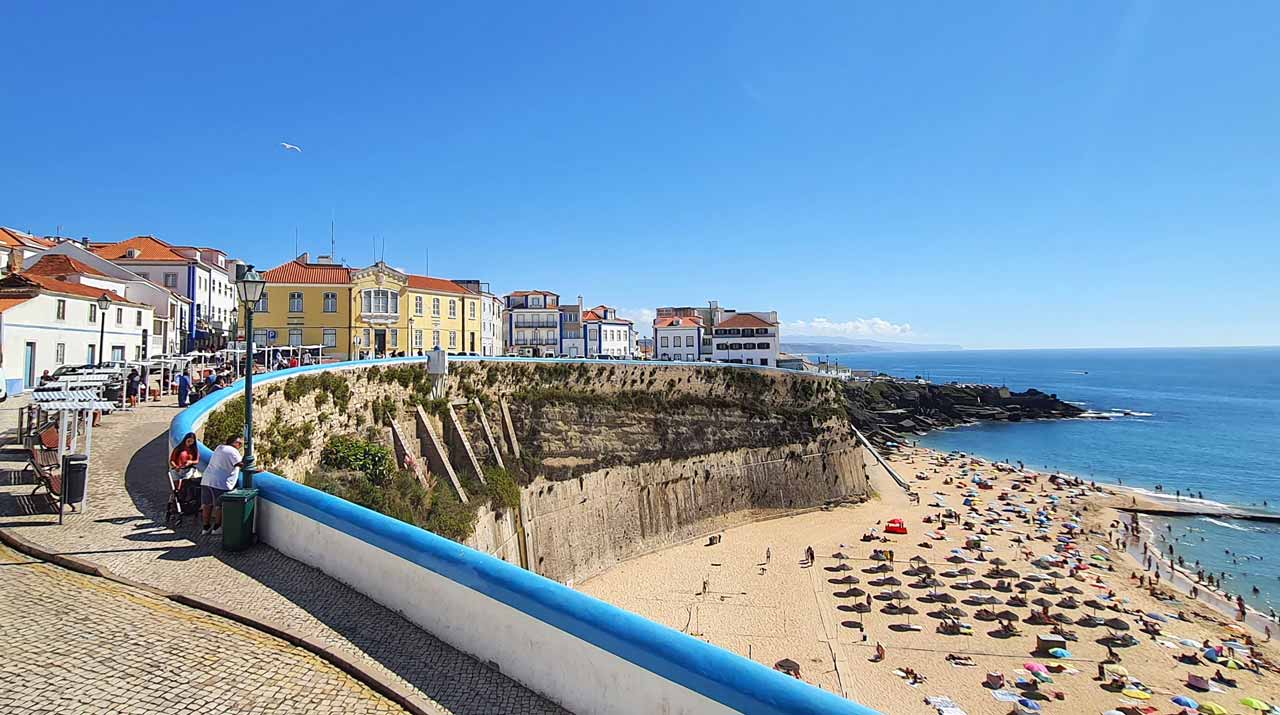
Ericeira is a small fishing town turned surf mecca, home to quaint blue and white houses, dramatic cliffs, and Europe’s only World Surf Reserve. Spend the day surfing at Ribeira d’Ilhas, exploring the old town, or feasting on fresh seafood with ocean views.
Getting there: Ericeira is around 50 minutes from Lisbon by bus. If you’re keen to surf, you can book a surf lesson or take a day trip to explore both Ericeira and Mafra Palace nearby.
Évora
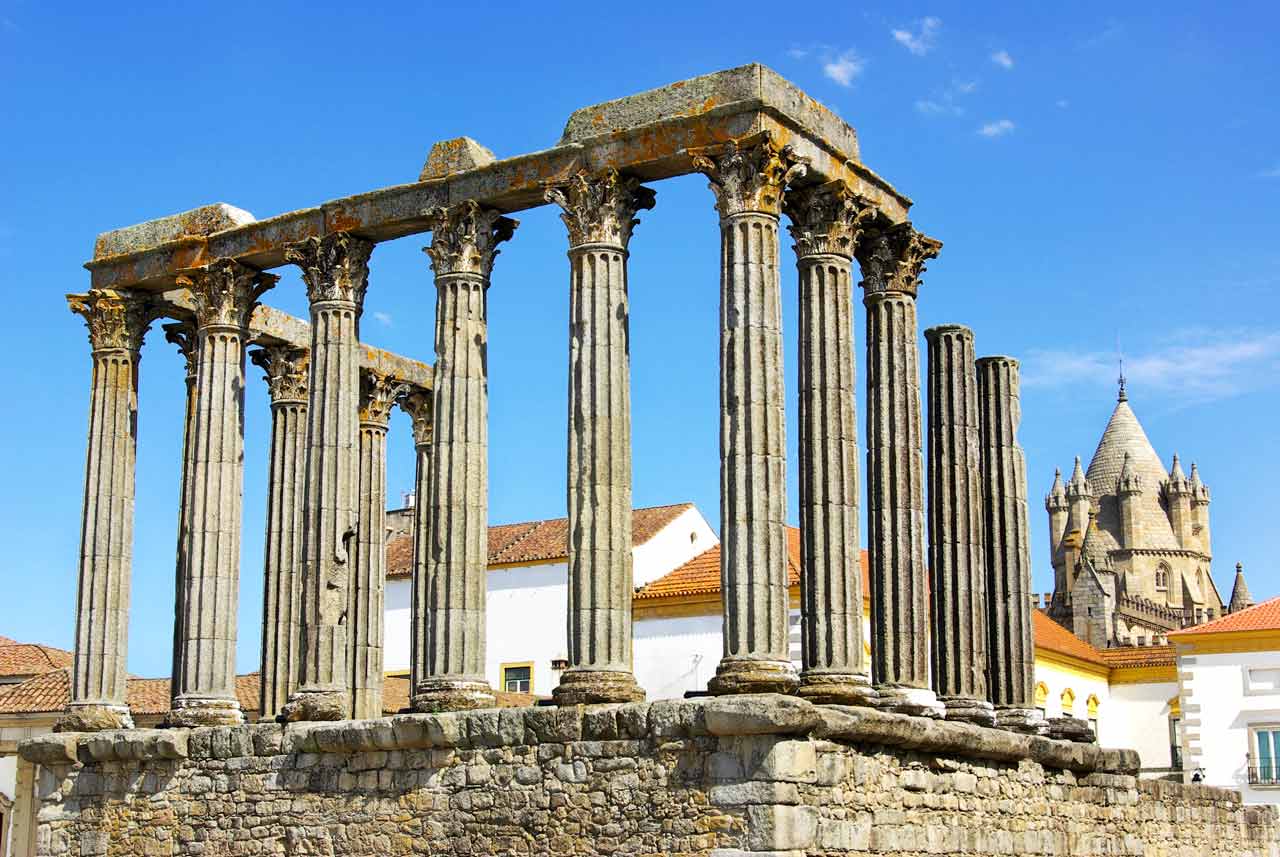
Évora, a UNESCO World Heritage city in the Alentejo region, is packed with history from Roman temples to medieval cathedrals. Highlights include the Temple of Diana, the eerie Chapel of Bones, and the Almendres Cromlech, a megalithic site older than Stonehenge!
Getting there: Évora is about 90 minutes from Lisbon by train or bus. Taking a guided tour of Évora and the megaliths makes for a rewarding and stress free day trip.
Fátima, Batalha and Alcobaça
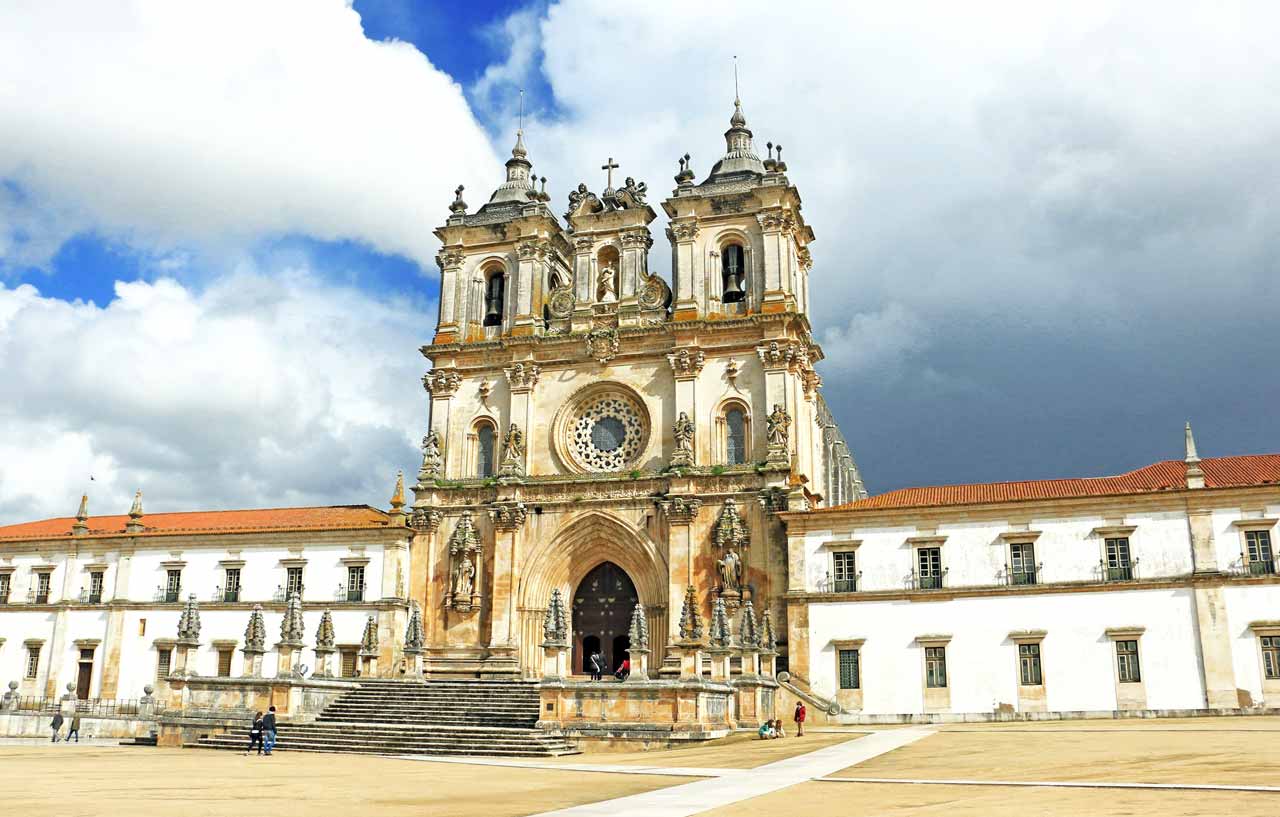
If you’re interested in history and religion, you can visit three major sites north of Lisbon in one day. Fátima is a world-famous Catholic pilgrimage site, Batalha Monastery is a Gothic UNESCO treasure, and Alcobaça Monastery holds the tombs of King Pedro and Inês de Castro, Portugal’s star-crossed lovers.
Getting there: These places are hard to cover in one day using public transport. It’s a long trip but best done with a guided tour that usually also includes Nazaré and Óbidos, such as this full-day tour or this shorter tour without Alcobaça.
READ MORE: My Epic Spain and Portugal Road Trip
Lisbon Travel Guide
Before booking in your Lisbon itinerary, here’s everything you need to know before you visit Lisbon, including:
- When to visit
- How to get to, and get around Lisbon
- Where to stay
- What to eat
- Essential Lisbon travel tips
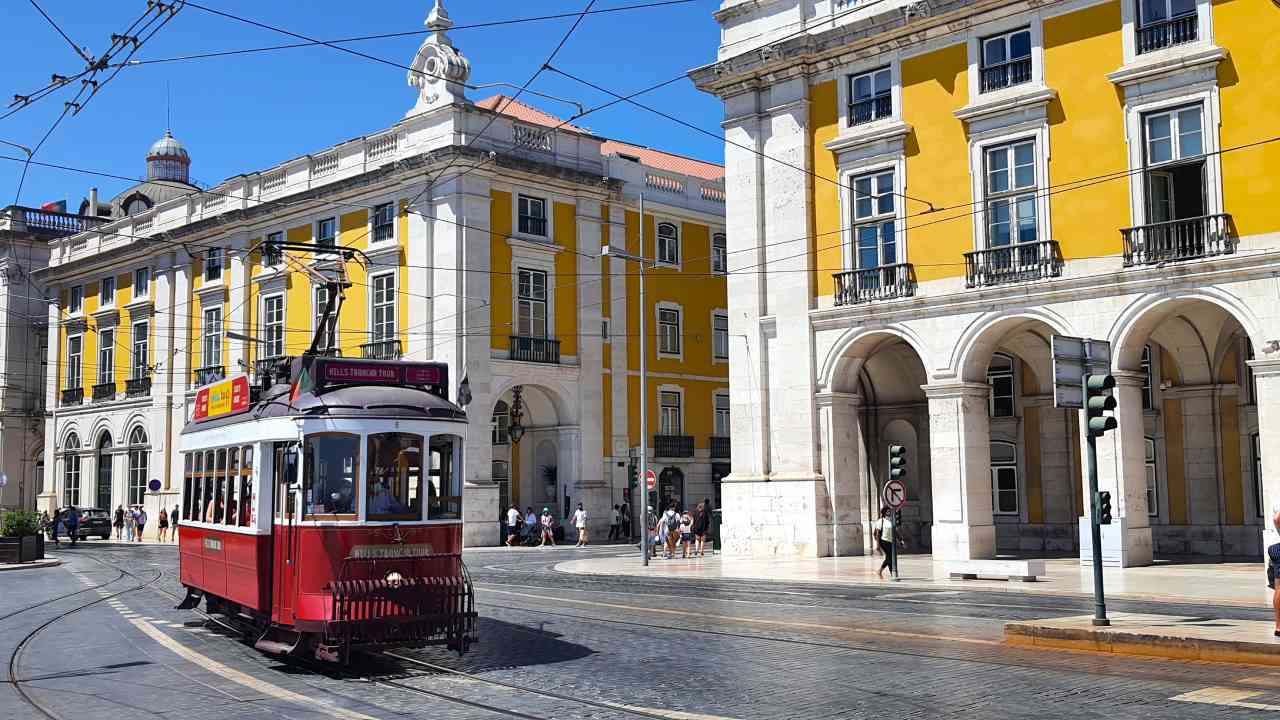
When to Visit Lisbon
Lisbon is one of those cities that always has something going on, there’s never really a bad time to visit. But, depending on your tolerance for heat, crowds, or drizzle, some months might suit you better than others.
Spring (March to May)
This is my favorite time to be in Lisbon, the city feels alive without being too busy. The weather is warm without being too hot, with average highs from 17 °C (62 °F) in early spring to 24 °C (75 °F) by late May. Late spring is especially pretty – the purple jacaranda trees start blooming in May and spill over the sidewalks, outdoor cafés fill up, the sunsets stretch longer, and you can explore without having to dodge the crowds.
Summer (June to August)
In summer, it gets pretty hot by afternoon, and Lisbon is not known for shade. Temperatures can hit the mid-30s°C (mid-90s°F), and the city’s famous hills become more of a workout. But it’s also when the entire city feels the most alive – festivals, markets, rooftop bars and long beach days all make it worth it if you don’t mind crowds and can pace yourself. Just book your accommodation early for the summer holiday peak season, and time your sightseeing for the cooler mornings and evenings.
Autumn (September to early November)
Autumn is another good time to visit Lisbon with temperatures ranging from 15 °C (59 °F) to 26 °C (79 °F). September in Lisbon is a sweet spot – it’s still warm enough to eat outdoors or take a day trip to the beach, but most of the summer tourists have gone. October is cooler but still mild (you might need a light jacket), and it’s a good time to explore at a more relaxed pace with less crowds.
Winter (late November to February)
Lisbon in winter is cool, quiet and more affordable. You’ll find empty viewpoints, cozy restaurants, and cheaper hotel prices, although outdoor seating areas may be closed. It rarely gets very cold (temperatures usually hover between 8°C and 15°C / 46°F–59°F), but it can be rainy, grey and damp. That said, if you’re not coming for beaches and sunshine, winter is a great time to explore the cultural side of the city without the rush.
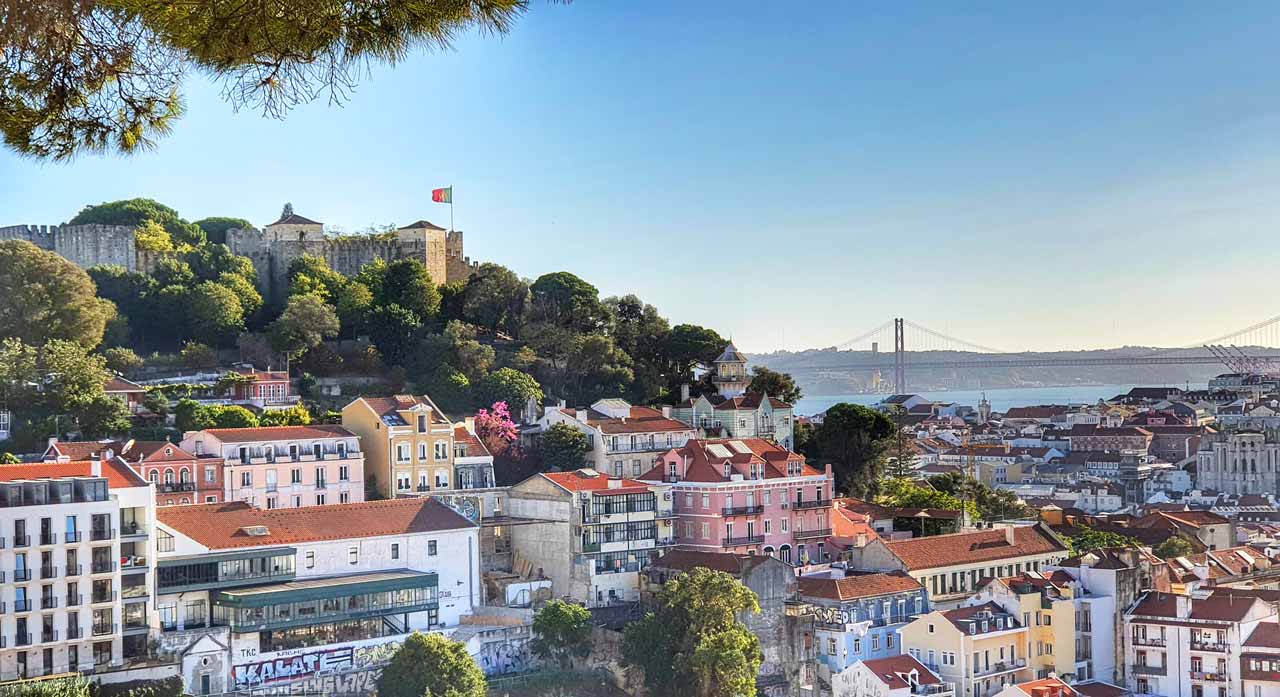
Getting to Lisbon
The easiest way to get to Lisbon for most people is by air. Buses and trains are also a good choice if you’re already elsewhere in Portugal or neighboring Spain.
Lisbon Airport (LIS) is well connected and welcomes international flights from Europe, Africa and America as well as a few domestic flights. The airport is surprisingly close to the city center – just 6–7 km away – and is connected by road and metro.
How to get into Lisbon city center from the Airport:
Metro (Red Line)
Lisbon’s metro connects the airport with the city,. It’s the most budget-friendly option and it’s surprisingly smooth and easy.
The Red Line starts right at the airport and connects you to Saldanha, where you can change to the Yellow Line for the historic center, or continue to Alameda for the Green Line.
It takes about 30–40 minutes to get into central Lisbon and the single fare costs around €1.65.
Uber / Bolt
Uber and Bolt both work really well in Lisbon and are often cheaper than traditional taxis. You can get to most central areas of Lisbon for around €10–€15 depending on the time of day.
Just make sure you have a working SIM card, eSIM, or WiFi hotspot to call your cab, then follow signs to the designated ride-share pick-up point outside the Arrivals terminal..
Taxi Cab
Official blue and black taxis wait in the designated taxi stand just outside Arrivals, and offer a convenient way to go straight to your hotel without any fuss – just make sure they use the meter.
Private Transfers
If you prefer to have someone waiting for you with a name card, you can pre-book a private airport transfer. It’s more expensive but wins for convenience if you’re arriving late, have lots of luggage, or are traveling with family.
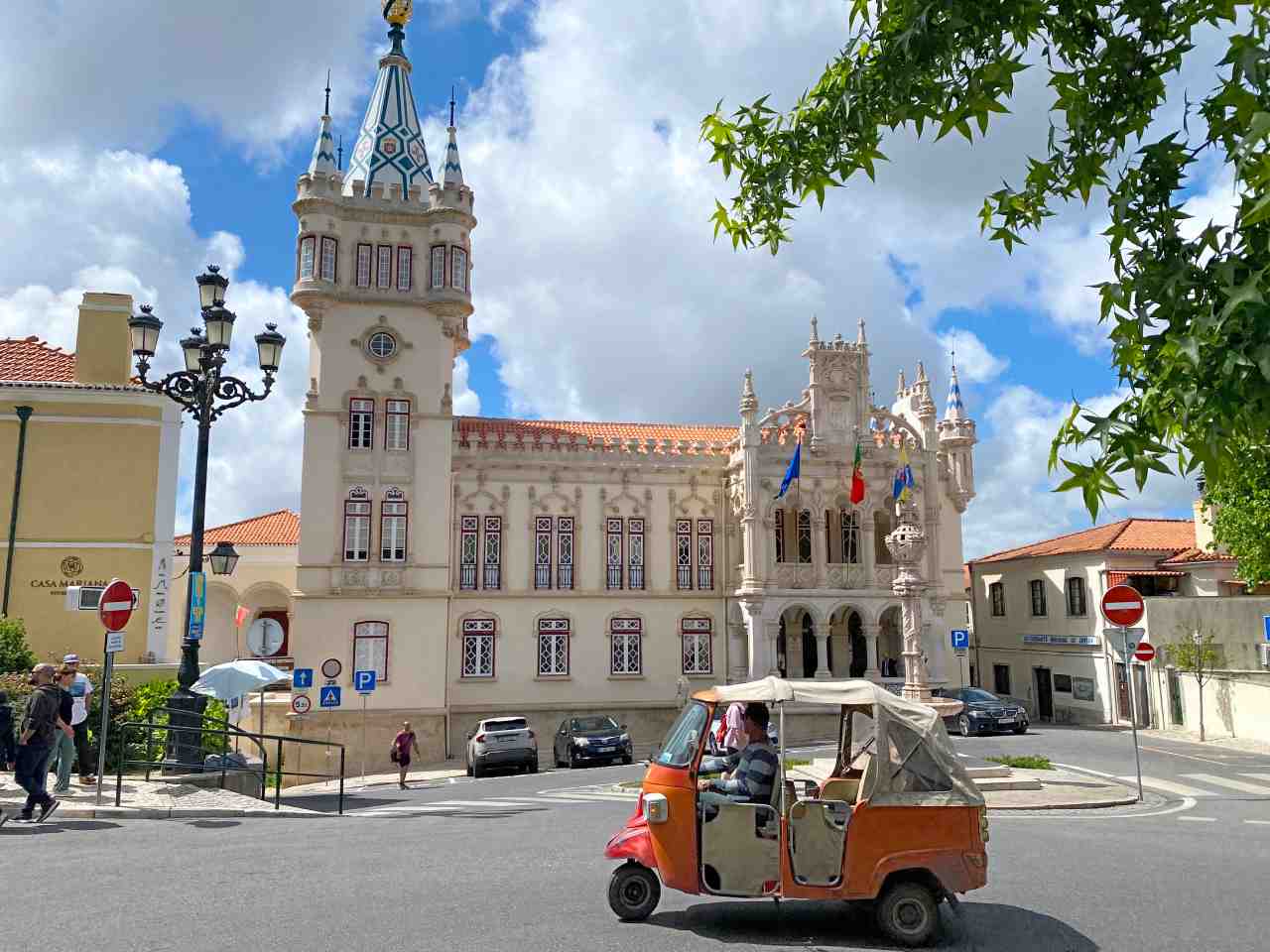
Getting Around Lisbon
Lisbon’s layout can seem tricky to navigate at first glance. The city is built on seven hills (yes, like Rome), and some streets are steep cobbled lanes where cars barely fit. But, once you get the hang of it, getting around Lisbon is easy. Especially if you mix walking with public transportation.
Walking
In the flatter parts of town, like Baixa, Cais do Sodré, and Belém, walking is lovely,. But in places like Alfama, Graça, and Bairro Alto, be prepared for steep climbs and uneven cobblestones, which can be slippery when wet. I recommend decent walking shoes or trainers, not sandals, heels, or flip-flops, for exploring Lisbon by foot.
Public Transport
Lisbon’s public transport system includes metro, trains, trams, buses, funiculars and elevators and ferries. To use public transport pick up a Navigante occasional card (previously known as Viva Viagem) from the ticket machines or service counters at any metro station. It costs €0.50 and is valid for one year.
Once you have a card you can load it (“Zapping”) with funds which are used up as you pass through the automated gates at metro, bus and tram stations around the city. As long as you have sufficient credit on the card you won’t have to buy any individual tickets on much of Lisbon’s public transport system.
If you plan to take more than 3–4 rides in a day, the 24-hour pass (€6.80) is good value – it covers metro, buses, trams, and funiculars (even the Santa Justa lift.) You can select this 24-hour pass from the ticket machines when you top-up your Navegante travel card.
Metro lines
Lisbon’s metro is compact but efficient. There are four lines (red, green, blue, and yellow), and they connect most of the key areas. The metro is safe, air-conditioned, and easy to use, even if you don’t speak Portuguese. Trains come frequently and run from around 6:30 a.m. to 1:00 a.m.
Tram lines
Lisbon has both old and new style trams. The old yellow trams, like the iconic Tram 28, are called Remodelado trams and wind through the historic areas of Lisbon. They are a fun way to sightsee and one of the most iconic Lisbon experiences.
Bear in mind that the tram carriages are quite small and very popular with tourists. They get really packed and you need to watch out for pickpockets. The newer trams, however, are much larger and smoother.
Tram lines run throughout central Lisbon, and out along the coast as far as Belem. Check out this Google Maps overlay to see which lines go where.
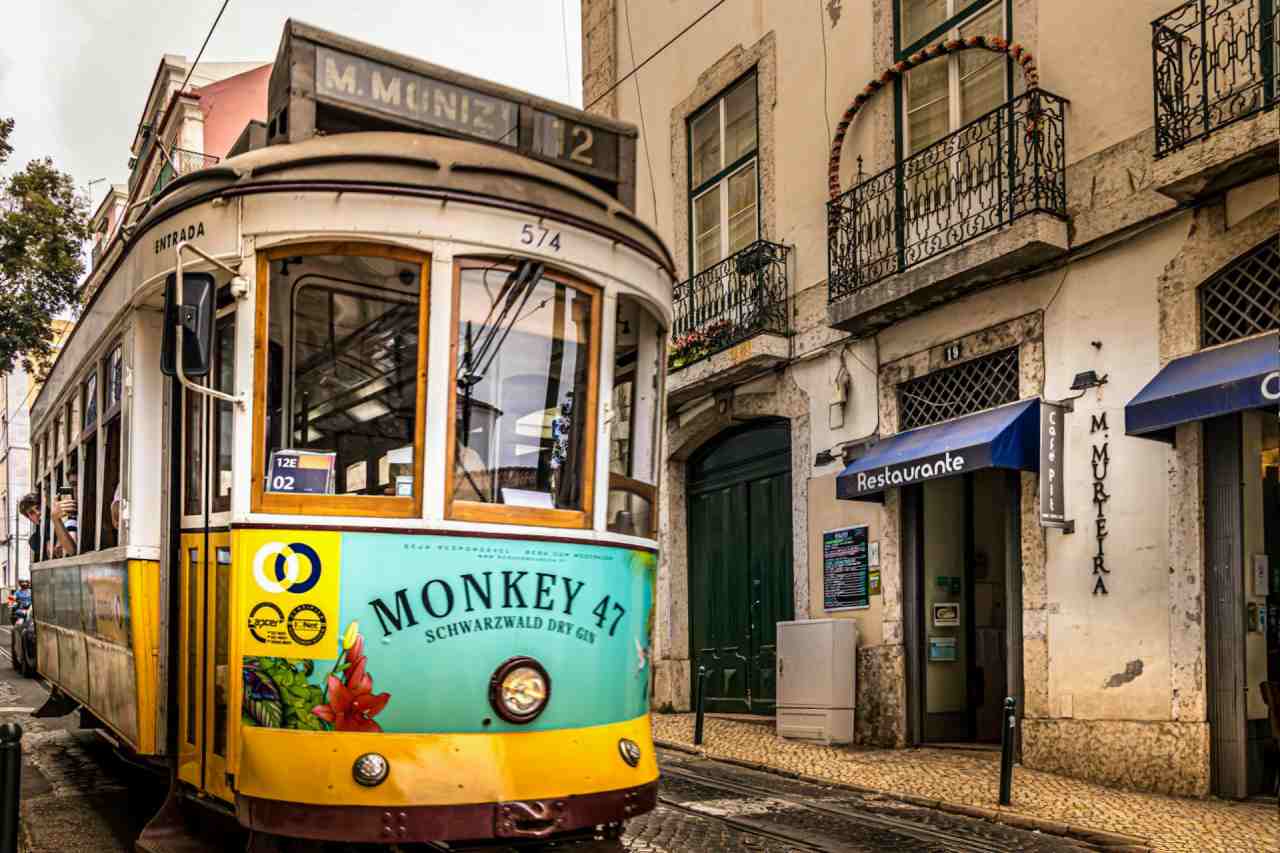
Funiculars and Elevators
These quirky forms of public transportation connect lower parts of the city to higher areas – saving your legs from the steep climb. However, their carriages only have a small capacity and they are also popular with tourists, so it’s often quicker to walk up than wait in line.
If you’re prepared to queue for this fun Lisbon experience, I think the three elevators worth checking out are;
- Elevador da Glória – connects Rossio and Baixa with Bairro Alto, handy for reaching the Miradouro de São Pedro de Alcântara.
- Elevador da Bica – this super cute yellow tram offers a photogenic ride up the steep street between Cais do Sodré and Bairro Alto.
- Elevador de Santa Justa – an architectural gem that connects Baixa with Carmo Square and Chiado. It’s very popular so be prepared to wait a while.
Buses and Train lines
Lisbon’s public bus system, operated by Carris, is extensive and inexpensive. It’s a simple and convenient way to get around the city and out to surrounding areas.
Regional trains run frequently and are cheap, safe and ideal for day trips to places like Sintra and Cascais. The main stations are Rossio (for Sintra), Cais do Sodré (for Cascais), and Oriente or Santa Apolónia (for Porto and the rest of Portugal.)
Ferries
If you want to explore the other (less touristy) side of the Tagus River in Lisbon, go to the Cais do Sodré ferry terminal and take a ferry over to Cacilhas. You can pay for your journey with a Navegante Card (the same card you use for the metro). The crossing takes 10-15 minutes and you’ll get excellent views of the 25 de Abril Bridge as you travel.
Scooters and Bicycles
There are plenty of e-scooters and bikes for rent (via Lime, Bolt, Gira, etc.), but Lisbon’s hills and cobblestones make them a bit dicey. They’re best for the flat riverside paths in Belém or Parque das Nações.
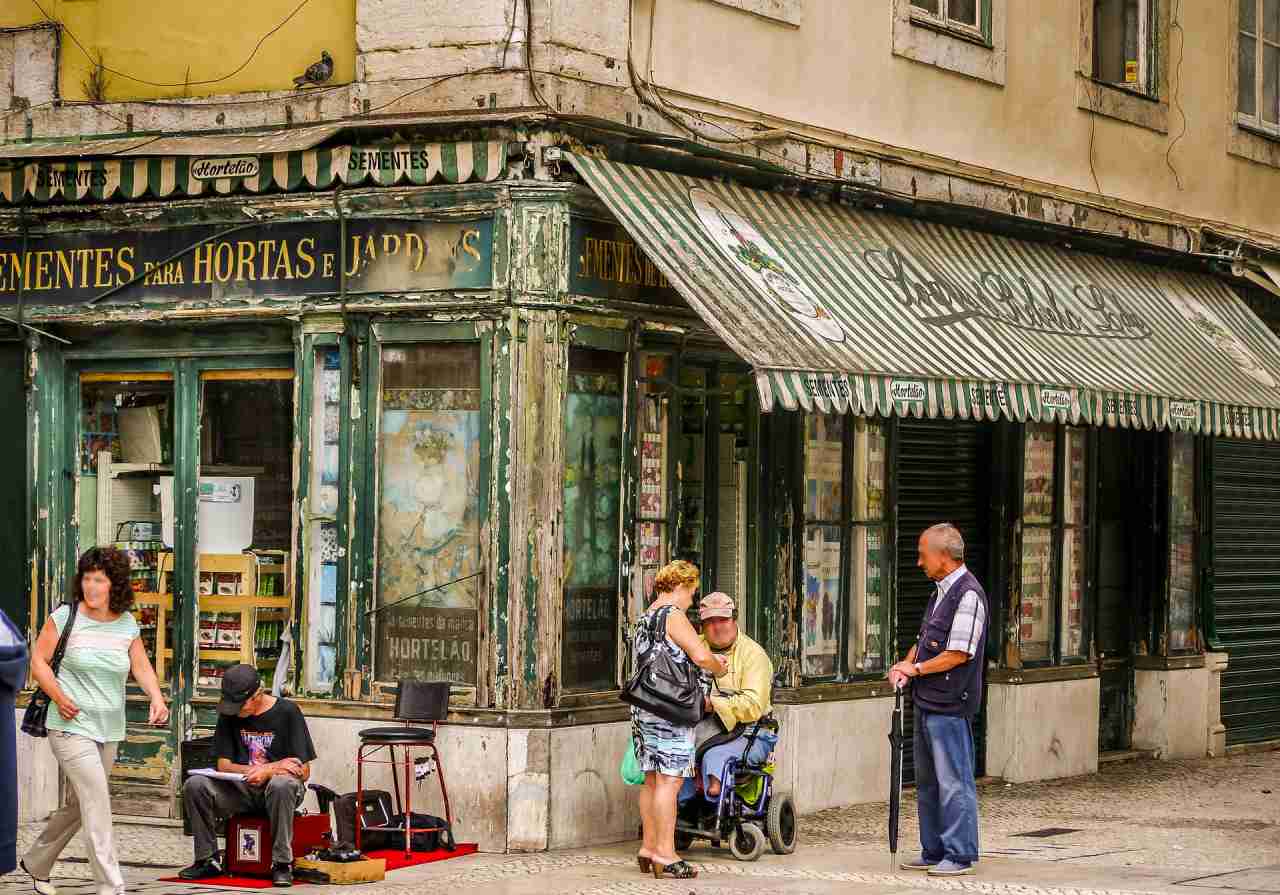
Where to Stay in Lisbon
While Lisbon is no longer as cheap as it used to be, there is still a wide range of accommodation options to suit different budgets and travel styles. Luxury historic hotels, boutique guesthouses, family hotels, modern apartments, and backpacker hostels all have their place in Lisbon.
To make the most of your time here, base yourself in or near the historic centre. That will make it easier to explore on foot and cut down on time spent navigating the hills and reaching public transport.
The city is made up of several distinct neighbourhoods, each with its own character. When choosing where to stay, it’s worth considering the area’s vibe, noise levels, and how close it is to the sights you want to visit.
The Best Areas to Stay in Lisbon:
- Baixa and Chiado are historic, centrally located areas that are well-connected by public transport. These elegant and charming areas are a good choice if you want to be close to shops, restaurants, and the main squares. They’re quite touristy and can be more expensive than staying further out, but it’s very convenient for a short stay.
- Alfama is the oldest part of the city, with narrow alleyways, steep streets, and plenty of traditional charm. It’s a beautiful area to explore, but not the most practical place to stay if you don’t like stairs or plan to get around by car or tram.
- Bairro Alto is one of Lisbon’s liveliest areas in the evening. It’s full of bars and music venues, so it’s probably not the best place to stay if you’re looking for peace and quiet. That said, some of the side streets are quieter, and you’ll be close to lots of attractions and nightlife.
- Principe Real is a more residential neighbourhood just above Bairro Alto. It has a relaxed feel, some nice cafés and boutiques, and is still within walking distance of the centre. It’s a good option if you prefer to stay somewhere a bit quieter and more local.
- Cais do Sodré sits between the city centre and the river. It’s known for its nightlife and the Time Out Market. Some parts can be noisy at night, but it’s a convenient base with good transport links.
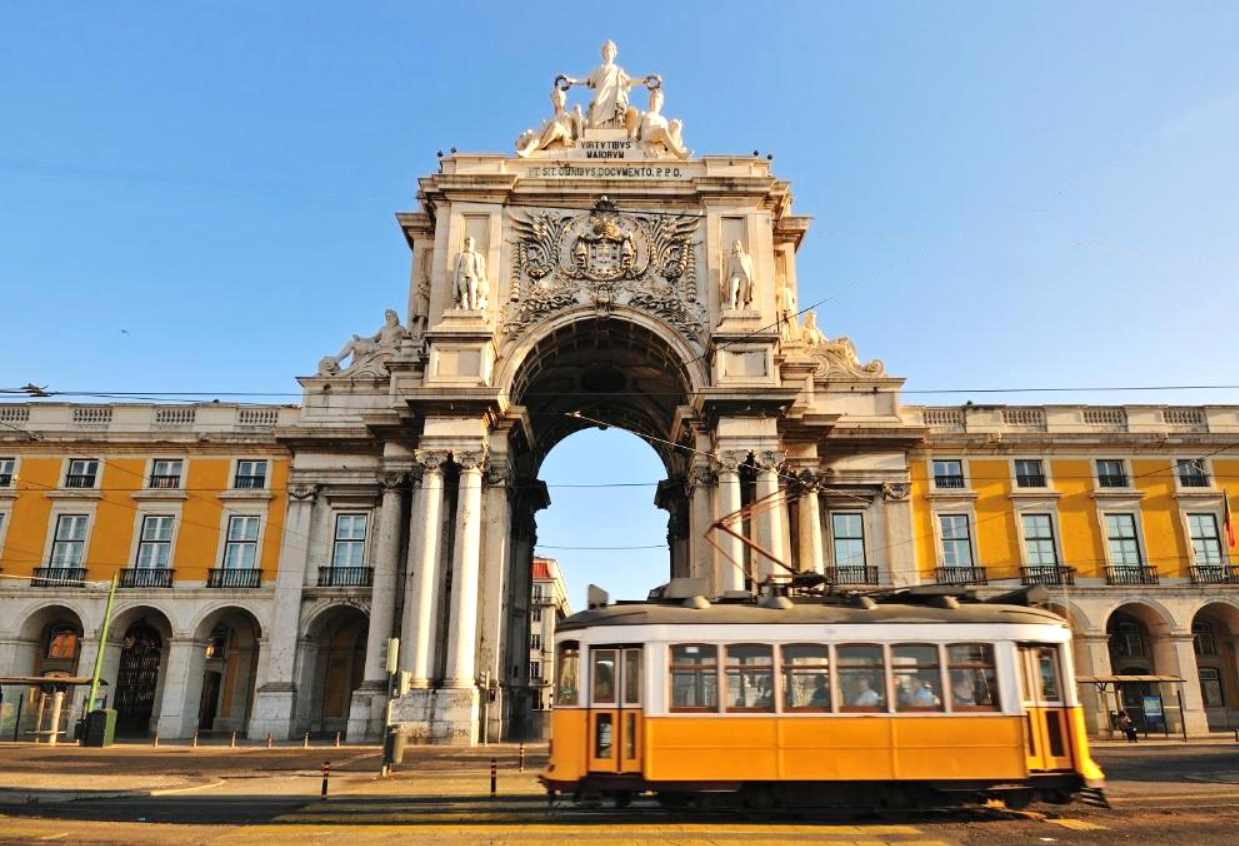
Best Hotels in Lisbon
If it’s your first visit to Lisbon, I recommend staying in Baixa or Chiado as this gives you easy access to exploring the historic city and the surrounding area. Hotels here are a bit more expensive but you’ll be immersed in the most beautiful parts of the city and it will allow you to make the most of your time here.
These are my recommendations for the best hotels in Baixa and Chiado:
- Luxury: Pousada de Lisboa – This gorgeous historic 5 star hotel, member of Small Luxury Hotels of the World, offers timeless luxury in the most iconic location. Situated right on the Praça do Comércio, Lisbon’s main plaza, this hotel offers 200 years of history complete with elegant rooms, river views, an excellent restaurant, and even a small indoor pool to relax after a day of sightseeing.
- Mid-Range: Hotel do Chiado – A lovely 4 star hotel with fantastic views over the city from the contemporary rooms and amazing rooftop terrace, plus an amazing buffet breakfast
- Boutique: Hotel Lis Baixa – Authentic, friendly Lisbon hotel on a quiet yet centrally located street. The rooms have little balconies and there’s an onsite restaurant offering al fresco dining.
- Budget: Lisbon Destination – Popular hostel located in Rossio train station with an amazing courtyard, free breakfast, and fun social activities. Both dorms and private rooms are available.

My Top Lisbon Travel Tips
Here’s a few more useful tips to consider before visiting Lisbon. Let me know in the comments if you have any of your own Lisbon tips to share!
Lisbon is no longer a cheap destination – The Portuguese capital was known as one of the cheapest cities in Western Europe. While some things, like food and public transport, are still pretty affordable, centrally located accommodation is in high demand and comes at a price so budget accordingly.
Save money with a Lisbon Card – With so many attractions to visit in Lisbon, the cost of entry tickets can soon add up but you can save money by picking up a Lisbon Card that gives you free access to 52 museums and historic buildings, plus free rides on public transport. You can buy a Lisbon Card here, with a choice of 24, 48 or 72 hour validity.
Wear comfortable shoes – Lisbon is famously hilly and full of cobblestones which can be slippery when wet. Even short walks can be tiring, especially in Alfama, Graça, or going up to the viewpoints so make sure to pack good shoes with grip for walking.
Lisbon can be windy – Even on warm days, the breeze, especially near the river or coast, can catch you off guard. Bring a light jacket or scarf, even in summer.
Book the major tourist attractions in advance – The most famous tourist attractions like Palácio da Pena, Quinta da Regalia and Jerónimos Monastery, and even some walking tours or food experiences sell out quickly. It’s best to book your time slot in advance, especially in spring and summer.
Expect late dinners and light breakfasts – Locals usually don’t eat dinner before 8 PM. Traditional breakfasts are simple—just coffee and a pastry. If you want something more substantial in the morning, head to a brunch café in areas like Príncipe Real or Cais do Sodré.
Bring cash – Most restaurants and shops take cards and contactless payments, but small cafés, kiosks, bakeries, and old-school tascas often prefer cash for small transactions. Look out for Multibanco ATMs for lower cash withdrawal fees.
Check opening hours – Many museums are closed on Mondays, and some smaller businesses close for a few hours in the afternoon. When planning your itinerary for Lisbon always check the opening hours, especially on public holidays.
Learn a few Portuguese words – Many people in Lisbon speak some English, but a quick obrigado/a (thank you), bom dia (good morning), or por favor (please) is always appreciated. Try and learn some simple Portuguese phrases before you visit.

Where Next?
After Lisbon, why not explore more of Portugal? If you have time you could head up the coast to Porto – Portugal’s charming 2nd city or, if the beaches are calling, head south towards the Lagos and Faro in the Algarve.
If you only have time for one more destination I would recommend Porto. The distance from Lisbon is about 320 km, which takes around 2.5 hours on the train. If you are not in a rush consider renting a car and making it a road trip – there’s plenty to explore on the way to Porto. The Atlantic coast is home to endless beaches, legendary surf spots and charming fishing villages like Ericeria, Peniche and Nazare, where you can learn to surf at some of the best surf camps in Portugal.
Ready to Plan Your Own Lisbon Itinerary?
I really hope you found my Lisbon itinerary useful. Please feel free to adjust it according on your interests and how much time you have for your trip. I’ve tried to include all the best things to do in Lisbon, and links for buying advance tickets to the most popular attractions.
Have an amazing trip and enjoy exploring amazing Lisbon. Tchau!
–
Check out more of my Lisbon and Portugal blogs:

